 Guided Missiles Destroyers
Guided Missiles Destroyers
74 ships (90 planned) DD 963-DD 997 1988-2030
Flight I, II, IIa, III
Cold War US DDs:
Fletcher DDE class | Gearing DDE class | Gearing FRAM I class | Sumner FRAM II class | Forrest Sherman class | Mitscher class | Farragut class | Norfolk class | Charles F. Adams class | Spruance class | Arleigh Burke classWhat else to close this year than the current Arleigh Burke class destroyers. Designed in the early 1980s they were a product of the cold war, designed to marry AEGIS capabilities of a Ticonderoga class cruiser with more rounded capabilities than the 1970s Spruance class ASW destroyers. It was hope to weave this into a single and more versatile package, but still the “low-end” ships types wanted by Zumwalt. In 1984 it was still hoped each would cost about 2/3 as much as a Ticonderoga, while offering 3/4 of her AA potential… These 70+ destroyers built in successive batches, modernized a lot over the past 35 years, are still built today and for the foreseeable future, as the backbone of the USN with a planned 90 ship total fleet. They are prepared today still for the though Challenges to come, notably in Asia. But the announcement as a complement frigate, the constellation class is expected to share bit of their current burden, provided they are built at all… In the meantime, the Burke class remains the naval bulwark of the free world. Happy Xmas. #usn #usnavy #aegis #arleighburke #zumwalt #missiledestroyer
Development
Foreworld
The Arleigh Burke class guided-missile destroyers (DDGs) were back in 1990 a new breed centered around the Aegis Combat System developed initially for the Ticonderoga (but which roots went back to the USS Enterprise and Long Beach) married with the new SPY-1D multi-function passive electronically scanned array radar. The class name was a tribute WW2 destroyer Admiral Arleigh Burke, later Chief of Naval Operations (CNO). USS Arleigh Burke was also commissioned during Admiral Burke’s lifetime, which is rare, on 4 July 1991. USS Cushing was the last Spruance class decommissioned on 21 September 2005, making the Arleigh Burke-class the only active destroyers until the Zumwalt class of 2016. With the longest production run of any U.S. Navy surface combatant (74 active by 2024, 19 planned to join) they are also supposed to replace the last Ticonderoga class cruisers, the last cold war legacy ships with the Nimitz class.
Capabilities are key here. Despite a still moderate lenght of 505 feet (153.9) -but grater beam- on a 8,300 tons displacement, their missile complement, courtesy of two large VLS fore and aft, went up to 90 missiles, making them the more heavily armed ships in US inventory, better even than previous guided-missile cruisers. These VLS tailored for a great diversity of payloads proved a true multi-mission destroyer could be built as first envisioned, comprising anti-aircraft defense, antiship strikes, tactical land strikes and anti-submarine warfare. Their AN/SPY-1 radar systems and associated missiles making up for a more advanced Aegis Ballistic Missile Defense System and later AN/SPY-6 radar system added to this anti-ballistic missile and anti-satellite capabilitie, making them true swiss knives; a true do-it-all marvel which explains why it was produced for so many years. If the program is carried out to its conclusion, with production numbers only comparable to WWI and WW2 wartime figures, the USN would have nearly 100 surface combatants of the same class (A global tonnage of 900,000t for destroyers alone), a true backbone. Future will tell if Chinese vessels larger than the Type 055 needs an answer. They are indeed capable of carrying a combined 112 missiles in VLS.
Origins and Flight I
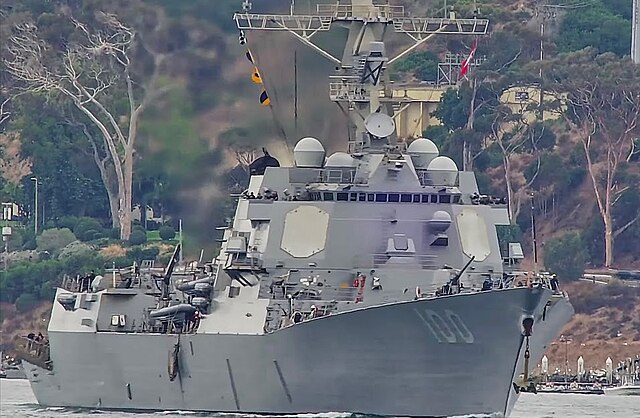
The new USS KIdd (DDG-100), renamed after a decommissioned Spruance class sub-class lead vessel
The idea behind the Spruance class successors, which design went all the way back to 1968-69 when it was necessary to counter the latest Soviet SSNs, are found in Chief of Naval Operations (CNO) Admiral Elmo Zumwalt’s drive between 1970 and 1974. He envisioned modernization at minimal cost and advocated for a “high-low mix” with a few high-end and high-cost warships backed by many low-end, low-cost warships. The idea was somewhat implemented with the couple Spruance/Ticonderoga in the early 1980s. The first filled the high end and the second, the low end, but it was later estimated that the aging Charles F. Adams class destroyers would also need replacement, if possible with lower-cost Aegis-equipped ships to complement the “low end” offer. Studies were thus based on this Adams class replacement schedule, not to replace the Spruance class at first.
In 1980 design studies thus ramped up and expanded to reach seven contractors with tenders. In 1983, three had been retained: Bath Iron Works, Ingalls Shipbuilding, and Todd Shipyards. In between the “winner takes all” approach professed by Mc Namara’s “wiz kids” was considered not the best solution and on 3 April 1985, Bath Iron Works was awarded US$321.9 million to design and build the lead ship USS Arleigh Burke while venerable Gibbs & Cox’s architecture studio from New York, behind so many US ships, was awarded the contract as lead ship design agent. They would halped later make sure other yards would stick to the design in detail. And this was Ingalls Shipbuilding, contrated for the second ship.

From the DDX program 1978-79 it was renamed the DDGX program from 1979-1980. Here is a line drawing of an early DDGX design proposal showed in Proceedings, January 1982. It had no gun and and an austere AEGIS version, eight harpoons, two VLS and two CIWS plus triple Mk.46 TTs and helideco aft but no hangar. Some stealth features are already in the superstructure buy the hull is very much the same as a Ticonderoga, albeit flush.
Between 1980 and 1985, there were many discussions about details of the design, but some features were retained early on. First of, the VLS (Vertical Launching System) was still planned at the time to be installed on the Ticonderoga class cruisers from USS Bunker Hill (CG-52) and seemed more primising to deliver saturatation fire. There were still delays between launches, and the twin-arm classic Mark 26 launched was still quick to launch and reload, but the Mark 41 VLS was still in its infancy and it was hoped to improved the launch speed over time.
However from the start, a LAMPS III helicopter for at least preserving the ASW capabilities of the Spruances was not certain. Political restraints meant the “low-end” would be restricted hull-wise (8,300 tons) and if helicopter were present, the limited hull size meant at first no helicopter hangars based on a hull 50-foot shorter than the Ticonderoga’s. Compromises were made in design that led to notably, a new type of wide flaring bow to preserve buoyancy and stability.
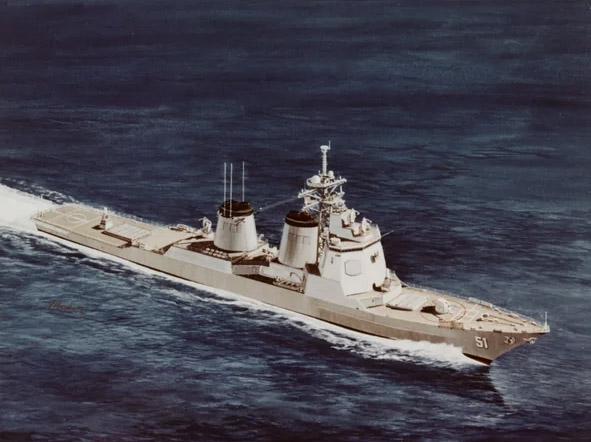
DDGX Concept artist, by P. Piecyk, sept. 1981.
Still, the hull could have an associated large bow sonar and the new towed sonar in development. The VLS was supposed to carry the venerable ASROC was well for medium range ASW strikes and the closer range, secured by the old and trusted Mk 32 triple torpedo tubes plus decoys (Nixie) and other systems.
Missiles such as the SM-2 standard as main SAM for air defence, 20mm Phalanx CIWS for close defense (plus again jammer EW and decoys) as anti-ship defense, and the Harpoon and Tomahawk for anti-ship and land strikes were all in the inventory and sure to be part of the package.
However the limited length were meant to be powered at first with 80,000 shaft horsepower (shp) LM2500 gas turbines. Later in desig they were augmented to 100,000 shp in the same space. The initial Burke design was also devoid of main gun, again due to size constraints, but later it was decided as a minimal option to shoehorn a compact OTO Melara 76 mm. Eventually with more tweking it was possible to reintroduced the trusted 5-inch/54-caliber Mark 45 common to the Spruances and Ticonderoga. Decisions were made on structure as well and lessons learned meant no aluminium alloys for the superstructure, but all-steel. The weight was however better balanced and steel plates made more flexible and lighter.
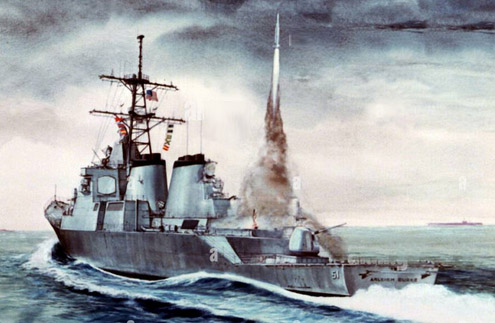
Same as above, DDGX concept 1981
Total cost for the lead destroyer was still $1.1 billion, as she was a trailblazer. Not precisely the definition of a “low end vessel”. But it was hoped to have it lowered as the serie developed. Already the second ship was less costly. On this, for the lead vessel, $322 million for the ship itself, poweprlant and zll equipments onboard including the electronics and sensors suite, and $778 million for the weapons systems. USS Arleigh Burke was laid down in Maine on 6 December 1988, so four years from order to laying down the keel, time to generate all the technical blueprints and start pre-production. Indeed modularity was present from the start and all suppliers needed to setup production of sub-components. Production over the years will be faster. The lead ship was launched on 16 September 1989 (by Mrs. Arleigh Burke) and the ret. Admiral himself was present at her commissioning ceremony, on 4 July 1991. It was held on the waterfront in downtown Norfolk in Virginia. What later became “Flight I” went on until 1995.
Design of the class (Flight I)
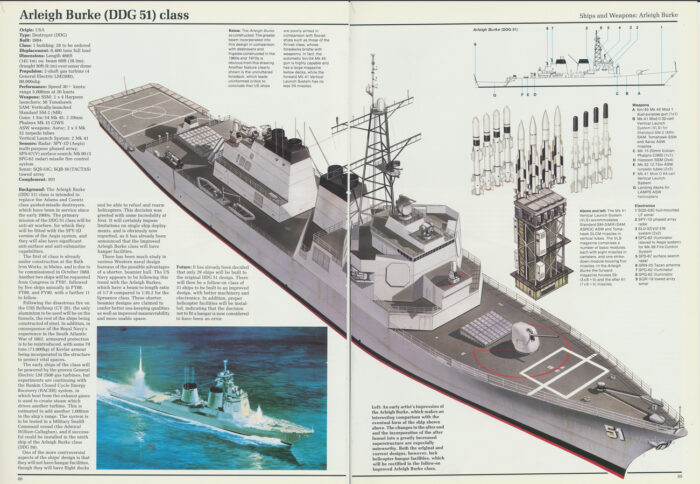
From Modern Naval Combat, 1988
The Arleigh Burke-class were for sure large destroyers, among the largest built in the United States, in the new tradition setup by the Spruance and Kidd (563 ft or 172 m). The Zumwalt classes (600 ft or 180 m) are a bit oif an exception and more cruisers than destroyers, although the term is today virtually meaningless. There is a debate to be made about the role and use for a cruiser in thius day and age, but this will not be today. Let just say that operating alone to hunt down merchant traffic is no longer relevant. The Arleigh Burke, by integrating AEGIS essentially retook the capabilities of a cruiser under a destroyer skin. They are still usable in independent missions outside carrier battle groups, their traditional assignment, like piracy patrols, monitoring, command and control in some area, etc.
The Arleigh Burke class was born of compromises in lenght, not tonnage, and so engineers had to design a hull that would retain fine waterlines while still maximizing space and keep an important deck surface and internal volume. This was challenging, and the solution came from a few tricks. The most sticking point was a new large, water-plane area-hull form caracterized by a wide flaring bow improving seakeeping and transitioning from a finer waterline beam, with entries that enable top speed in most circumstances, including in high sea states. The other innovation, unknown from previous Spruance and Ticonderoga design, was the inclusion of stealth techniques: They had angled surfaces and a raked tripod mainmast to reduce her cross-section and makde her appear much smaller on a radar.
The angles surfaces in addition received a coating which absorbed part of radar waves and this was improved on the next Flights. The goal on the long run was to make the class appear as small as a trawler on a radar signature classification.
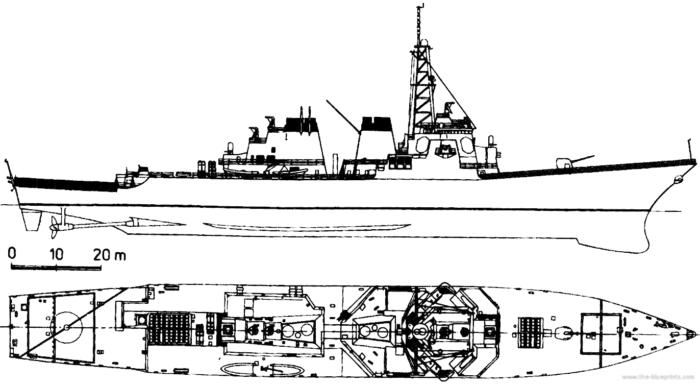
Initial design, 1985. Note the derrick, later replaced by a tripod mast, less affected by radar detection due to its raked, triangular section masts.
Lessons from the Ticonderoga-class cruiser design were also incorporated. The latter were deemed too expensive for continuing the serie. Notably their crew was too large, and modularity was lacking. In short they were difficult to upgrade without causing stability issues. Thus for the new destroyers, they were made in all all-steel construction except aluminum for the mast, to reduce fire hazard, while maximizing internal space and greatly improve automation to reduce the crew (and associated costs). The previous Ticonderogas indeed had a steel hull but aliuminium superstructure to try to reduce their massive top weight (with the AEGIS associated AN/SPY-1A/B main radar array and bridge which sat on top notably), but it proved on the long run vulnerable to cracking in addition to be less fire-resistant.
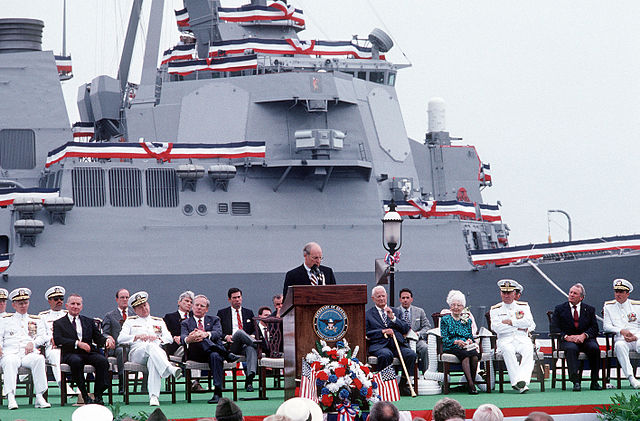
Secretary of Defense Dick Cheney delivering a keynote address at the commissioning ceremony for USS Arleigh Burke on 4 July 1991.
The USN was painfully aware of the limitations of that material with the 1975 USS Belknap fire already. It ate away her superstructure quite quickly despite effort to put it off. Another, more recent example were the damage suffered by Royal Navy destroyers in the 1982 Falklands War. The same Falklands War also led the Navy to want to better protect the Arleigh Burke class and notaby its vital spaces with double-spaced steel layers to buffer from anti-ship missiles detonations. For the first time also, Kevlar spall liners were integrated in all sensitive areas, lighter than steel and yet offering greater resistance to fire and offering extra flexibility.
Arleigh Burke’s Hull and General Design
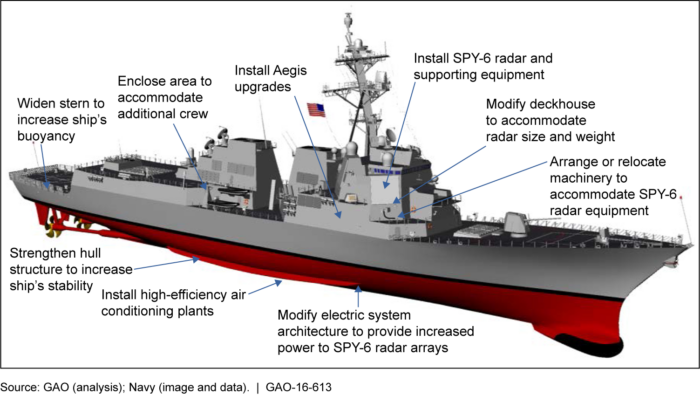
Explanations of the design, as completed in the 1990s. Src: USNI.org pdf, https://news.usni.org/2016/08/08/document-gao-report-flight-iii-arleigh-burke-guided-missile-destroyer
The Arleigh Burke were indeed relatively short, at 505 ft (154 m) versus 567 feet (173 m) for the Ticonderoga and (563 ft or 172 m) for the Spruance/Kidd which was indeed much shorter and seen as a problem in heavy weather due to wave length calculations. However as seen above this was compensated by several measuresn, like the greater flare given to the hull resulting in finer entry lines, necesary to compensate notably for the lesser light/beam ratio. Indeed, these ships had a beam of 66 ft (20 m) making for a 1/7.7 ratio versus the Spruance’s beam of 55 ft (17 m), for a 1/10.1 ratio.
The greater beam was a toough choice due to the need for extra safety built in the hull, and the angled hull as in reality, waterline-wise it was reduced to 59 feet or 18 m and a waterline lenght of 466 feet (142 m) so a real waterline ratio of 7.8/10, so nearly 8/10. Still not optimal, but this was compromise partlu based on the promise of more efficient, yet lighter and more compact gas turbines. The wizards of Gibbs and Cox were at the helm, still.
As for draught, they were deeper at 31 ft (9.4 m) to both the Spruance (29 ft (8.8 m)) but less than the Ticongerogas at 34 feet (10.2 meters). The latter were the most concerned about topweight after all. Indeed, far what it brought in terms of inetrnal space, the Arleight Burke were remarkably compact and looked futuristic.
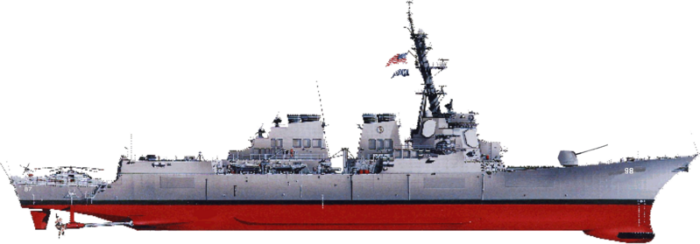
In general, the stealth impreative forced the designers to go with a much cleaner design than anything that came before. Both the Spruance and Ticonderoga were quite “boxy” in their general appearance, with a lot of complicated strutures in between which all could catch and bounce radar waves. The new tendency born in the 1980s was to try place everything if possible behind angled surfaces, resulting in a still “boxy” but also angular approach to achitecture. This was reflected in the hull also which was more angular. For example the prow started its ascent from the base of the forward structure in a straight line instead of a progressive curve.
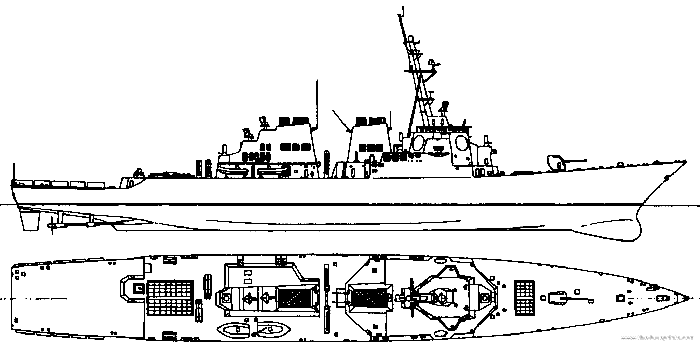
There was no bulwark to to the steep angle of the bow forward. Like the pruance class the bridge block was as large as the hull, and there were two large funnel blocks with heat reduction measures. Instead of two masts, there was a single one, a derrick initially, later replaced by a peculiar, very raked tripod. Both the central, carrier pillar was triangular in section, but the supports were shaped with lozenge sections. A lot of care was place on the mast, which was tall and thus more susceptible to catch radar beams and the calculated, very raked angle was a technical challenge.
The clean rear island superstructure was stepped for the guidance radars, and pyramidal in section but narrower, and “stuff” was still found on either side. Like the captain’s cutter, other ships would receive ribs instead. Designers did not went the extra mile to enclose everything “sticking out” behind a light structure. This effort was made on the Zumwalt class, which had a greater sum of stealth features. This is also due to the time this design was first drafted with almost 15 years between them and the Zumwalt. The rear hull was beamy, in order notably to keep buoyancy, but this forced to design even more carefully the underwater section, to still keep the water flowing through the struts and rudders, propellers without much cavitation. As underwater another form of stealth started, the acoustic one.
Powerplant

To compensate for a less speed-friendly hull, beamer, with a deeper hull it was decided early on to improve on the propulsion. The originally-planned 80,000 shaft horsepower (shp) LM2500 gas turbines were thus upgraded to 100,000 shp. These General Eletric LM 2500 gas turbines rated each for 33,600 hp or 26,250 bhp (19,570 kW), with a power turbine speed of 3,600 rpm is used to drive two shafts with controllable pitch propellers, five-bladed reversible.
In addition to these, the Flights I–IIA runs three Rolls-Royce 501k34 Generators (3,000 kW (4,000 hp) each, 450 V and Flight III ships three Rolls-Royce 501k34 Generators (4,000 kW (5,400 hp) each for 4,160 V. The top speed is classified, marked “In excess of 30 knots” or 56 km/h, 35 mph. The Range is noted for 4,400 nmi (8,100 km; 5,100 mi) at 20 knots (37 km/h; 23 mph). When deployed in the Mediterranean, Rota in Spain is a point of entry and supply.
Protection
Passive protection
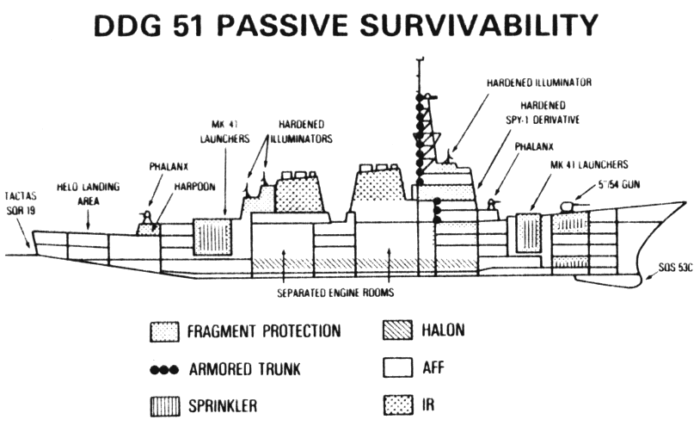
It was not the return of armour per se, especially since this was a destroyer class, and protection traditionally in the cold war focused on aicraft carriers as the most important asset of the fleet, not its escorts. Though, the Burke class would since have an “all or nothing” style scheme to protect its most essential organs without returning to the extensive protection of battleships or even cruisers. The idea was to use the available structure at its advantage and replace heavy steel with another material that could bring an ever better set of characteristics while be light enough. And this turned out to be kevlar. Extensive use of kevlar made these destroyers the best passively protected escorts in the USN by far.
Kevlar was (para-aramid, long form Poly-paraphenylene terephthalamide) one of the very first composites, invented by Polish-American chemist Stephanie Kwolek while working for DuPont, in anticipation of a gasoline shortage to create tires in 1964. The idea was to replace rubber by a fiber-base, strong, durable and still flexible material. The polymers used formed liquid crystals in solution, which was pretty unique. Adoption only came out fro tests, showing superior caracterstics to Nylon. It was soon declined for military applications as the KM2. It was breveted and marketed by DuPont as providing an efective, light fragmentation protection for the U.S. military, declined on Helmets and vests. It was not ready for use in Vietnam, at that time, M69 “Flak jackets” were available but way too heavy for use in the jungle. They were using layers of nylon fabric just like the antique “fabric armour” sets such as the ones sported by the Macedonians. From fiber glass panels later body armor integrated Kevlar and later ceramic heart plates as those par tof the model US slodier protection set Just as the bew M1 helmet.
Long story short, kevlar start to look promising for larger hardware as well, starting with aviation, such as the legendary A10 Thunderbolt II. In the Navy, it took a bit longer to be able to figure out the creation of massive plates. When viable, all vital areas were protected by two layers of steel and 70t of Kevlar armour as a sandwich. This combination had been tested notably against serious blasts, shrapnel, and was found very effective. This extra weight however was only applied to structures below the waterline to keep stability. This corresponded to the combat & command center buried below the bridge, box magazines such as the VLS and ammunition well below the main turret. Other sources points out this went in fact further, up to 130t of Kevlar armour, but its perhaps on later flights.
This tonnage is for kevlar alone, not the high resistance steel used (a long derivative of WW2 STS) layering the kevlar, so we talk of perhaps 300-400t or more dedicated to passive protection alone.
Another part was NBC protection. Cold war imposed that new standard, starting on ships such as the 1960s Charles F. Adams class, but it was limited still. This was certainly not omitted on latter designs but never developed as much as for the Burke class. This new suite comprised a full sealing of all spaces communicating with the exterior, notably the sturdy weather deck hatches and doors. There were indeed double air-locked hatches but also pressurized compartments.
The sealing imposes the use (otherwise necessary for crew’s comfort) of air conditioning system. In case of NBC threat detection, the pumps would create an internal overpressure to avoid contamination creeping in. In case of radiation detected, external pumps would be used to wash over the hull and superstructures, the ‘external countermeasure washdown system’.
By the way, all external walls had spall liner for internal protection against small shrapnel. External air is filtered anyway. Some solutions are not stranger to what NASA developed for its spacecrafts.
To protect from fire hazards there were sets of halon extinguishers and piping networks for water sprinklers in living and command spaces notably. There are also many stowage locations for manual Halon 1211 fire extinguisher bottes throughout the ship. Inside the VLS there is an emergency halon FE system also, and quick filler cocks in the gunnery ammunition room.
Whereas the sprinkers, using drinkable water, could swap to externally salt water if needs be, probably also filtered. There is however on each ship a small water desalination system. Special care was also given to the fully sealed and armoured Command Center at the heart of the ship, which large room can act as a buoyant “raft”. This aspect was computing cooling, in such a confined structure. Water sprinklers are also used inside the combat information center (CIC), and halon bottles are on hand everywhere.
At last there is also the fact that electronics are hardened against electromagnetic pulses, which can result from a high altitude nuclear detonation or EMP warhead. This sum made the Burke the best passively protected destroyers in the USN ever.
Active protection
Probably the most important aspect of thrse ships in the first place. They are ensuring the innner layers of protection are not crossed. This comprises a set of systems, probably pushed the most of any previous US destroyers.
AN/SLQ-32 electronic warfare (EW) suite
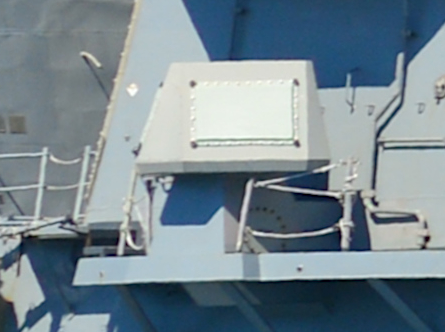
SLQ-32(V)6 on USS Porter, DDG-78.
This trusted system was built by Raytheo, Goleta (CA) and Hughes Aircraft Company, now the primary electronic warfare (EW) system in the USN. Colloqualy called the “Slick-32”. It appeared in the 1970s to replace the 1960s AN/WLR-1. It was declined since in many variants. Cuttently replaced by the Advanced Integrated Electronic Warfare System (AIEWS). USS Pinckney was the first of the serie IIa to be fitted with the SLQ-32(V)7 (SEWIP Block 3) in 2023.
SLQ-32(V)3-7
Later flights were equiupped with that enhanced EW suite, respectively SLQ-32(V)3 (Flight II), SLQ-32(V)6 (Flight IIa) and SLQ-32(V)7 (Flight III).
More to come in future updates. Shipboard electronic warfare suite from Raytheon Goleta and Hughes Aircraft, primary electronic warfare system nicknamed the “Slick-32”. The v(3) added antennas with electronic attack capability, to actively jam targeting radars and anti-ship missile terminal guidance radars. Later replaced with (V)6 and 7.
Mark 36 Mod 12 SRBOC
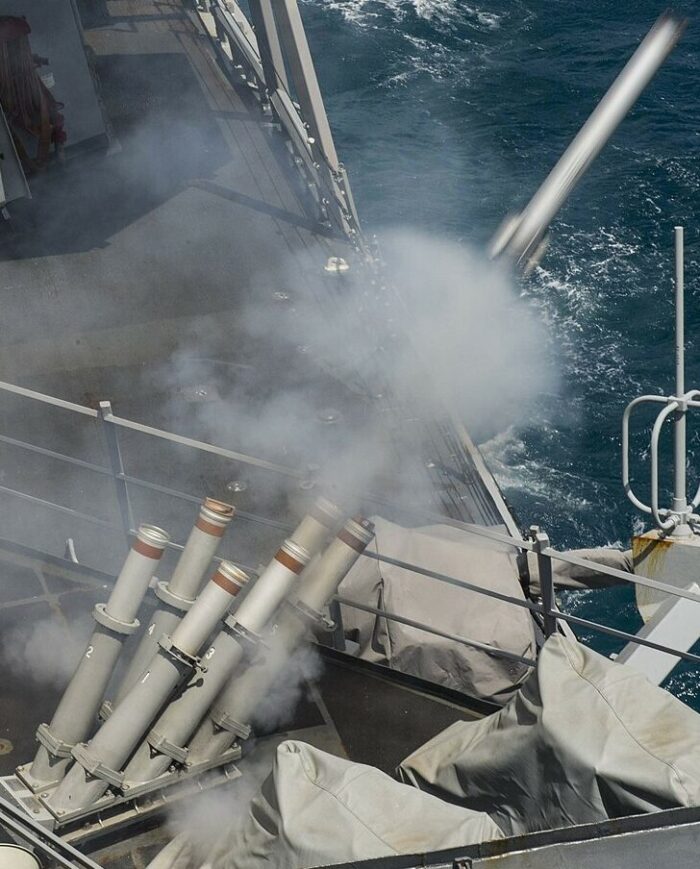
IR/chaff decoy launchers. BAE Systems Super Rapid Bloom Offboard Countermeasures Chaff and Decoy Launching System (SRBOC or “Super-arboc”), short-range decoy launching system for radar or infrared decoys. Two sets of six tubes either beam on upper decks, with reload canisters, manually loaded, launched through Aegis.
6x Mark 53 Nulka decoy launchers
These were a joint Australian-US decoy type which hovers in mid-air while drawing the incoming anti-ship missile. It was designed by Defence Science and Technology Group (DSTG), developed and produced in 2012 by AWA Defence Industries and now distributed by BAE Systems Australia, with 150 ships equipped as of 2017. The canister is contained in a dedicated launcher module, adjacent to the Mark 36 launcher. It was also combat proven: USS Mason, USS Ponce and USS Nitze, used these when coming under fire by two missiles fired by Houthi rebels off the the Yemeni coast in 2016.
Mark 59 decoy launchers
The Naval Decoy IDS300 (Inflatable Decoy System) is a passive and off-board, octahedral corner reflector decoy if british design and adopted by the USN, first developed for the Type 45 destroyer and now present on the Arleigh Burke-class destroyer. This is a persistent decoy which can float for up to three hours, in up to sea state 4. In US service it is designated the Mk 59 decoy launching system but made in UK at Irvin Aerospace Ltd in Hertfordshire. Launched by a deck-mounted tube its self-inflates on the sea surface and start to free-float past the stern to mimick the ship radar and radio signatures. A classic trick of past naval warfare as related by “C. S.” Forester. The process taks seconds and the decoy is independent from the ship. The destroyers receives four launchers, bolted, and requiring an electric launch. It is best use in littoral of calm waters due to wave clutter.
AN/SLQ-25 Nixie
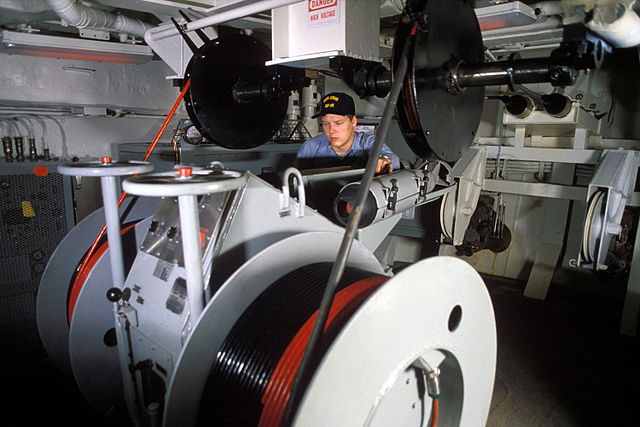
These “classic” towed countermeasures were developed for earlier ships and aimed at luring out incoming homing torpedoes.
Introduced in 1987, the towed torpedo decoy system comprises the towed decoy device (TB-14A) and shipboard signal generator to defeat wake-homing, acousting-homing, and wire-guided torpedoes. Mounted at the stern of the Arleigh Burke class behind a sliding panel.
Prairie-Masker
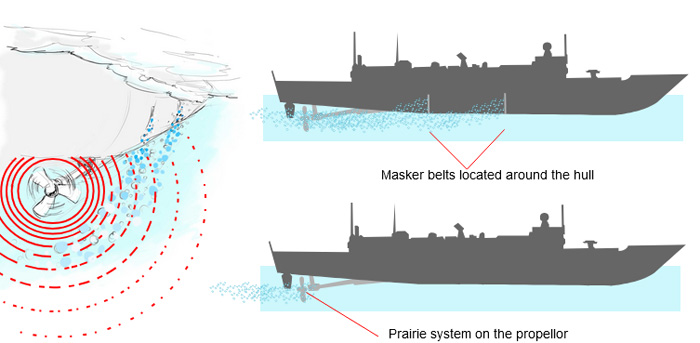
Systems used to reduce radiated noise. They were found on Oliver Hazard Perry-class frigates (now decommissioned), Spruance (too), Ticonderoga class cruisers (partly) and current Arleigh Burke-class destroyers. It had already tests going on in the 1960s on a few Guppy III modified boats and other SSKs. They are separated system working together, the Masker and Prairie systems both trying to prevent classification or identification of the ship’s acoustic signature. They are placed around the machinery spaces and propellers. Originally top secret, they are now quite common. The core principle is to create a sound speed (acoustic impedance) mismatch between the bubble curtain and seawater (Masker) in the shape of two bands fitted to the outside of the hull, adjacent the vessel’s engine rooms to inject compressed air, escaping through machined perforations creating a bubble air barrier.
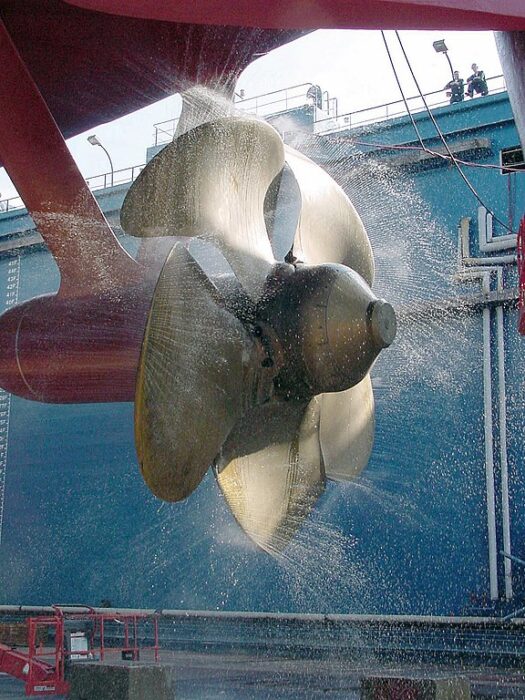
The prairie (from “propeller air-induced emission”) system focuse on propeller cavitation, the bubbles formed around the blade’s edges at high speed. In short, compressed air is pumped through small holes in the edges of the propeller to mask cavitation noise.
Armament
Mk 41 vertical launching system
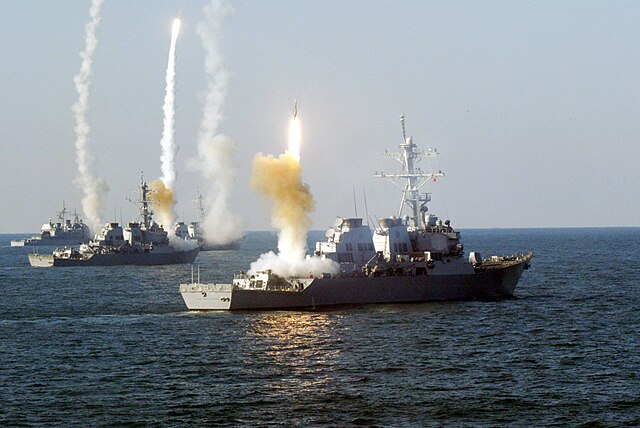
USS Vicksburg, Roosevelt and Carney firing their SM-2MR in a volley.
The cornerstone of the Arleigh Burke class. Each ships of Flight I and II comes up with one 29-cell forward and one 61-cell aft, for 90 cells total.
Flight IIa and Flight III push this to a 32-cell forward and a 64-cell aft for 96 cells total. The baseline system is design for 8 cells (see below).
This would be tool long to detail all the specifics of each missiles, so i will stick to a simple list instead:
RIM-66M surface-to-air missile
RIM-156 surface-to-air missile
RIM-174A standard ERAM
RIM-161 anti-ballistic missile (BMD-equipped ships)
RIM-162 ESSM
BGM-109 Tomahawk cruise missile
RUM-139 vertical launch ASROC
All but the last two are SAMs, with different ranges and capabilities.
The RIM-174A standard ERAM (Standard Extended Range Active Missile) also called SM-6 is the latest (2013) capable of Mach 3.5, capable of land strikes at 250 nmi (460 km) and with a ceiling of 110,000 ft (34,000 m), normal range of 130 nmi (150 mi or 240 km).
The RIM-161 ABM block IIa is capable of 1,200 km range and flight ceiling 900–1,050 km with two stages and a rocket motor for Mach 13.2. It’s the only naval anti-ballistic system of NATO.
The BGM-109 is the alternative to the Harpoon, needs no presentation
RUM-139 vertical launch ASROC worls like the good old ASW missile, compatible with all the light torpedoes described below.
⚙ specifications
MK 41 Mod 15:
32 cell Vertical Launcher Mk 177 Mod 0
64 cell Vertical Launcher Mk 176 Mod 0 Flight I-II
32 cell Vertical Launcher called Mk 177 Mod 3. Flight IIa-III
64 cell Vertical Launcher Mk 176 Mod 2. Flight IIa-III
They are all in pre-loaded canisters, and then loaded in individual cells wit variable lock depending on their diameter.
The Launcher cells are fitted as a baseline in 4 to 8 cell modules (in that case, 2 rows of 4) with a common uptake hatch or exhaust system sited between the two rows. The Mk 41 VLS was designed as highly modular to accept all sorts of canisters. The height is either setup at 209 inches (5.3 m) (base self-defense version), 266 in (6.8 m) tactical and 303 inches (7.7 m) strike. Empty weight for an 8-cell VLS is 26,800 pounds (12.2 t) then 29,800 pounds (13.5 t) and 32,000 pounds (15 t) for the others, to multiply to arrive to 32 and 64. Both the Ticonderoga and Arleigh Burke (up to DDG-78) have a Strike module fore and aft, five cells and a collapsible crane for replenishment at sea but this was considered dangerous and discontinued.
SeaRAM (1992)
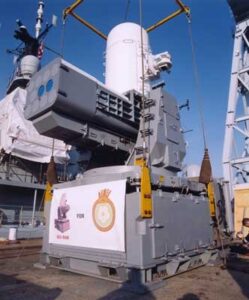 Missile replacement for the old Phalanx CIWS gun system. The SeaRAM combines a radar and electro-optical system, fully automated, and a large part of the Phalanx CIWS Mk-15 Block 1B (CRDC) system is kep, then re-equiupped instead with an 11-cell RAM launcher. Like the old Phalanx,with a possible pre-unit basis replacement, it sis fullu atonomous, without human input. It even uses the same power as the former system. In 2008, the first SeaRAM was delivered and installed on the Littoral class ship USS Independence. From November 2015, four Arleigh Burke-class of the 6th Fleet were so upgraded.
Missile replacement for the old Phalanx CIWS gun system. The SeaRAM combines a radar and electro-optical system, fully automated, and a large part of the Phalanx CIWS Mk-15 Block 1B (CRDC) system is kep, then re-equiupped instead with an 11-cell RAM launcher. Like the old Phalanx,with a possible pre-unit basis replacement, it sis fullu atonomous, without human input. It even uses the same power as the former system. In 2008, the first SeaRAM was delivered and installed on the Littoral class ship USS Independence. From November 2015, four Arleigh Burke-class of the 6th Fleet were so upgraded.
⚙ specifications (block 1)
Dimensions: 2.79 m (9 ft 2 in) x 127 mm (5.0 in) x span 434 mm (1 ft 5.1 in)
Launch weight: 73.5 kg (162 lb)
Speed: Mach 2.0+
Warhead: 11.3 kg (24.9 lb) blast fragmentation
Range: 10 km (6.2 mi)
Guidance: passive radio/infrared with posssible dual-mode enabled
Mk 141 Harpoon
Two anti-ship missile launchers installed on Flight I and II ships.
⚙ specifications
Two quad-tube canisters installed in transverse position between the rear structure and aft VLS and angled 45° port and starboard. Fires the RGM-84 Harpoon SSM in successive blocks.
Harpoon Block 1C: Present in large supplies, range 75 nmi (139 km) at 537 mph (864 km/h; 240 m/s; Mach 0.71), payload 488 pounds (221 kg).
Harpoon Block 1D (A/RGM-84F): For the Flight I destroyers, featuring a larger fuel tank and re-attack capability but production stopped after the Dissolution of the Soviet Union. Range 173 miles (278 km).
Harpoon Block II For possible installation on flight IIa and III. Marketed by Boeing as offering expanded engagement envelope, enhanced resistance to electronic countermeasures and improved targeting. Prod. started 2011.
Kongsberg Naval Strike Missile
Alternative to the Harpoon, tested only on DDG-62.
⚙ specifications
Deployed as naval strike missile (contract Nov. 2024) US$900, 5 years for the Over-the-Horizon Weapons System (OTH-WS) Program, to be installed on Littoral Combat Ships and CONSTELLATION-class Frigates when completed also.
5-in/54 Mark 45 Mod 1/2

Design from 1968, introduced in 1971 as the Spruance entered service. Fully automated instead of the previous weapon system, so it was much smaller and lighter but fired faster and more accurately. There were two, one for and aft on the Ticonderoga class, not modernized apart for the fire control sytem over the years.
⚙ specifications 5-in/54 Mark 45 Mod 0 |
|
| Weight | 21,691 kg (47,820.5 lb) |
| Barrel length | 8.992 m (29 ft 6.0 in) long. |
| Elevation/Traverse | −15° to +65° at 20°/s, traverse ±170° from centerline at 30°/s |
| Loading system | Barillet |
| Range | 13 nmi (24.1 km) |
| Guidance | Radar |
| Crew | Automated |
| Round | Shell 127 x 835mm (54 caliber) .R 31.75 kg (70.0 lb) |
| Rate of Fire | 16–20 rounds per minute, automatic 2,500 ft/s (760 m/s) |
Note: DDG-81+ receives the new 5-inch/62 Mk 45 Mod 4.
Phalanx Mark 15
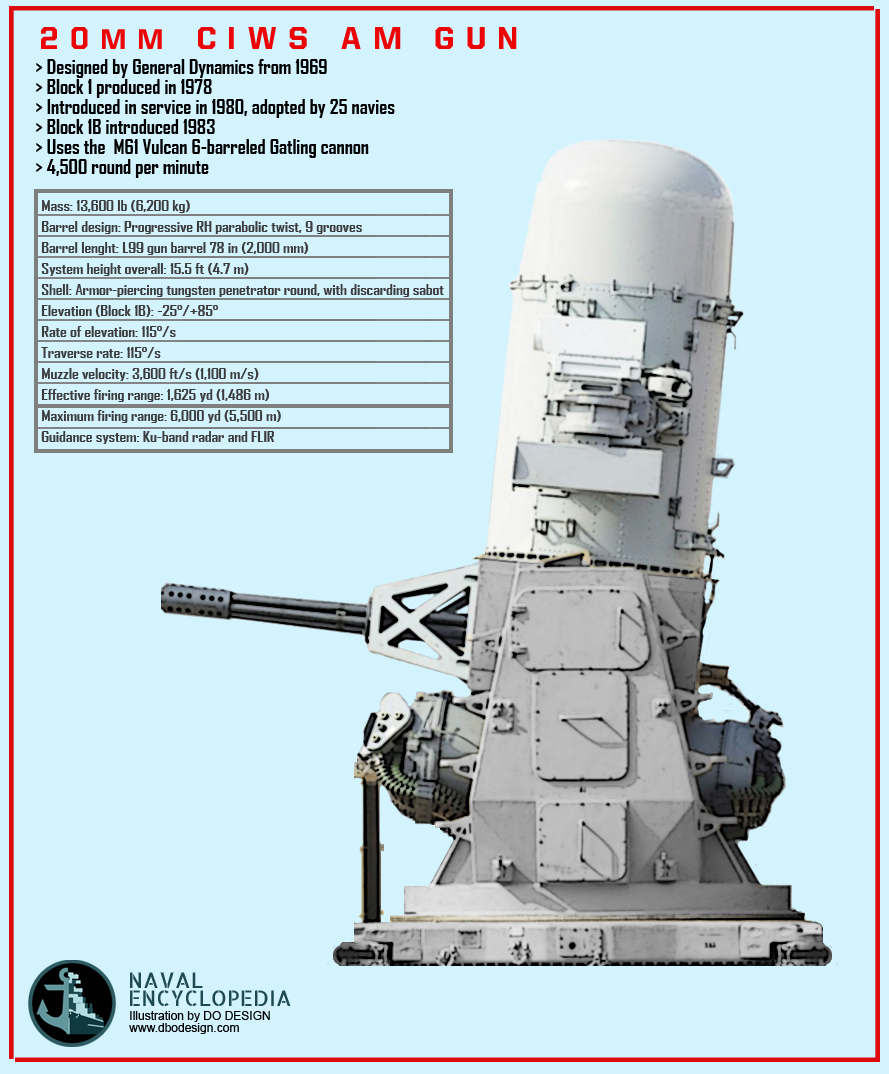
DDG-51 to 84 received two 20 mm (0.8 in) multitube Phalanx CIWS
DDG-85 onwards had a single 20 mm Phalanx CIWS.
Read more
ODIN
The Optical Dazzling Interdictor, Navy system is as much a protective and offensive asset, classed as “weapon”. Similar to dazzler of some main battle tanks, its goal is to dazzle an incoming missile, not destroying it. More to come.
Laser
From DDG-88 onwards, a High Energy Laser with Integrated Optical-dazzler and Surveillance replaced the ODIN system. More to come.
324mm Mark 32 TTs
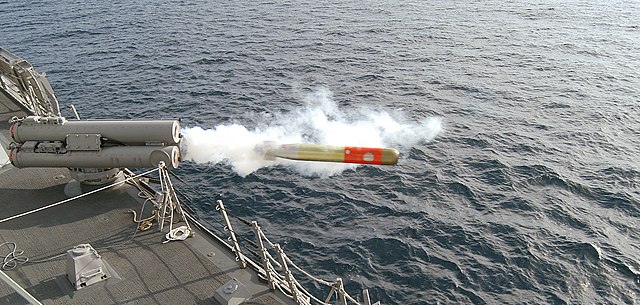
Each Ticonderoga class had two triple 2,230 lb (1,010 kg) launchers mounted on either beam, not on deck but internally in the hull, with a sliding panel protecting them. They were located at the level of the helideck. When the Ticonderoga class were active, these were the Mark 46 mod 5 and later 5A homing torpedoes that were provided. They were shared with the RUM-139 VL-ASROC.
These Mark 32 tubes can launch the following:
-Mark 46 lightweight torpedo (see below)
-Mark 50 lightweight torpedo: WH 100 lb (45 kg) HE shaped charge, 16,000 yd (15 km) range at 40 kts max, depth 1900ft (580m)
-Mark 54 lightweight torpedo: WH 96.8 lb (43.9 kg) 238Ib TNT, 10,000 yd (9 km) range at 40 kts, active/passive guidance
⚙ specs. 324mm Mark 32 TTs/Mark 46 mod 5 Torpedo |
|
| Weight | 508 lb (230 kg) |
| Dimensions | 8 ft 6 in (2.59 m) x 12.75 in (323.8 mm) |
| Propulsion | 2-speed, recip. ext. combustion, Otto fuel II |
| Range/speed setting | 12,000 yd (11,000 m) at 40 kn (74 km/h; 46 mph) |
| Warhead | PBXN-103 high explosive 96.8 lb (43.9 kg) |
| Max depth | 1,200 ft (370 m) |
| Guidance | Active or passive/active acoustic homing |
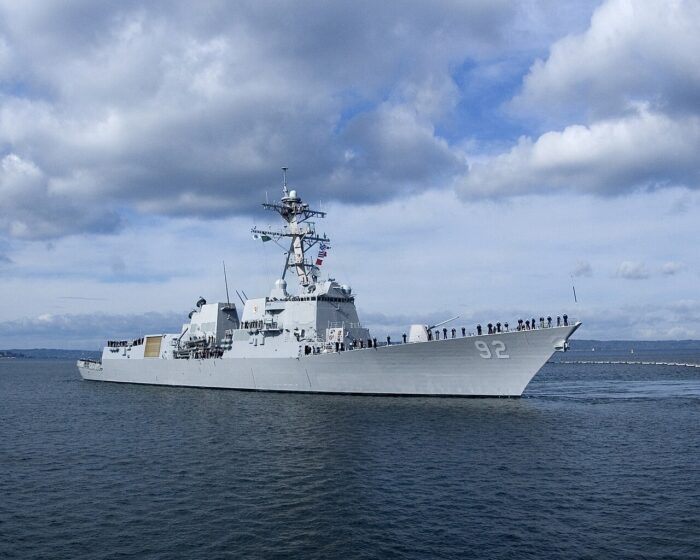
Sensors
AN/SPY-1D
PESA 3D radar installed on Flight I, II, and IIA. It was first installed on USS Arleigh Burke (DDG-51) in 1991, with all antennas in a single deckhouse. Variant of the -1B using the UYK-43 computer, same antennae for missile uplinks. New UYQ-21 display.
AN/SPY-6(V)1
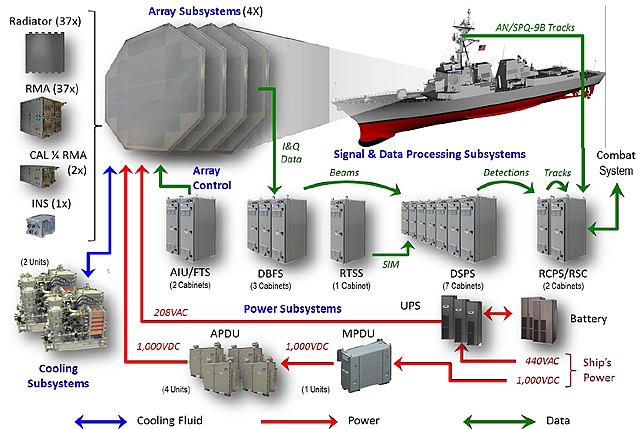
From Flight III (DDG-125), also by Raytheon. The Flight IIA (DDG-79 to DDG-124) are to be retrofitted with the AN/SPA-6(V)4. The AN/SPY-6(V)4 is a 4-sided phased array each with 24 RMAs, same caracteristics as below.
The N/SPY-6(V)1 is also known as the Air and Missile Defense Radar (AMDR), as a 4-sided phased array radar with 37 RMAs each. Estimated to have a 15 dB sensitivity improvement compared to the AN/SPY-1, locating targets half the size, twice the distance and simultaneous defense against ballistic missiles, cruise missiles, air and surface threats plus providing electronic warfare.
AN/SPS-67(V)3/5
Surface search radar installed from DDG-51 to DDG-118. Short-range 3D surface-search/navigation radar for highly accurate surface and limited low-flyer detection and tracking.
AN/SPQ-9B
More advanced model of surface search radar installed on DDG-119 onwards (Flight III). The 9A was installed on Ticonderoga-class cruisers. The SPQ-9B is for the Burke class, last flight. Twice the range, improved range resolution. Part of the Mk 160 Mod 11 Gun Computer upgrade, Mk 34 Gun Weapon System. Tested on USS Oldendorf (DD-972) in October 2002. X-band and the antenna with dual planar arrays back-to-back under a radome.
AN/SPS-73(V)12
Surface search and navigation radar installed from DDG-51 to DDG-86. Short-range 3D surface search/nav radar providing range and bearing data with signal processing and automatic target detection. More
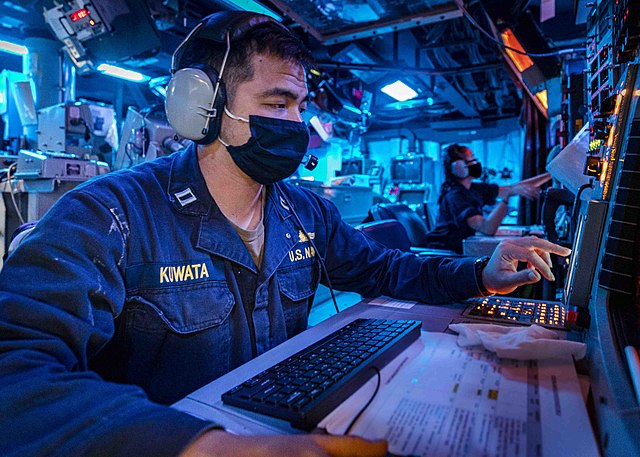
Combat information center aboard USS John S. McCain
BridgeMaster E
Surface search/navigation radar from DDG-87 onwards witrh commercial off-the-shelf components
AN/SPG-62
Primary missile fire control radar, three installed. Continuous wave fire-control radar coupled wit the Aegis Combat System, providing terminal target illumination notably for the SM-2MR/ER and ESSM Block 1 as well as SM-6 if in semi-active mode. Parabolic reflector used at 8 to 12 GHz, X Band, part of the Mk 99 FCS.
Mk 46 optical sight system (OSS)
Installed on Flight I, II, IIA. Developed by Kollmorgen in the 1990s, stabilized imaging sensor, for situational awareness. Used in congested waters and in nighttime operations. Supports the Mark 34 GWS with very accurate range (laser). Powered by the Stabilization Electronics Unit (SEU). Can also visually determine if the threat is eliminated. Protected by a shock isolation unit. Composed of the Above Deck Sensor Unit (ADSU) stabilized 2-axis director with a daylight, thermal imaging sensor and a laser rangefinder. Displayed in the CiC by the Control and Display Unit. Flight III are about to receive the Mark 20.
AN/SQQ-89 ASW combat system
-
SQS-53C sonar
Computer-controlled surface-ship sonar with both active and passive operating capabilities. Provides direct path ASW search, detection, localization, and tracking. Transducer assembly common to the 53A/B/C, hull-mounted. High-power, long-range under a large dome and with higher power and improved signal processing that all previous systems. Analog receivers upgraded to COTS processors on the SQS-53D. 1-10 kHz, range classified. The C variant is 50% smaller in volume and weight and had improved reliability with 2000 hours guaranteed before a possible failure. The transducers have a wider bandwidth. Coupled with the new AN/UYK-44(V) digital computers, plus the old UYK-1. More
-
AN/SQR-19
Tactical towed array sonar (Flight I, II, IIA)
-
TB-37U
Multi-function towed array sonar from DDG-113 onwards.
-
AN/SQQ-28
Heliborne system, LAMPS III shipboard system, dipping sonar.
Air Group
The Flight I and II of the class have no helicopter hangar, only a landing area “flight deck”. They also lacked the ‘coned’ smokestack. From Flight IIA, a dual capacity hangar was installed, but this cost one CIWS and the Harpoon SSMs, with a prepared location for reinstallation in wartime between the stacks. The latter were also redesigned for increased efficiency and reduced thermal and electromagnetic signature.
SH-60B Seahawk

The MH-60R Seahawk is a multi-mission maritime helicopter developed by Sikorsky Aircraft and is primarily used by the United States Navy. It is part of the SH-60 Seahawk family, which is itself a naval variant of the UH-60 Black Hawk. The MH-60R is designed for a wide range of missions, including anti-submarine warfare (ASW), anti-surface warfare (ASuW), search and rescue (SAR), naval gunfire support, surveillance, and vertical replenishment (VERTREP).
It carries the AN/APS-153 Multi-Mode Radar, AN/AQS-22 Airborne Low-Frequency Sonar, AN/ALQ-210 Electronic Support Measures (ESM) and Forward-Looking Infrared (FLIR) system.
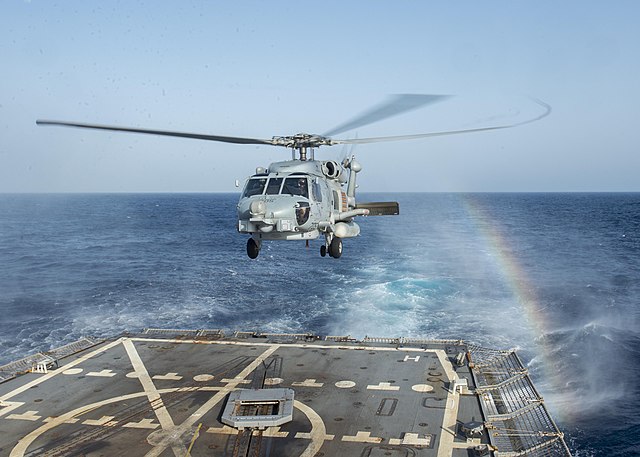
LAMPS II Seahawk HH-60 landing on USS Bulkeley, note the catching system useful in heavy weather.
Typically equipped with Mark 54 torpedoes for ASW but also AGM-114 Hellfire missiles against surface targets and a crew-served M240 or GAU-21 machine gun.
Crew of 3-4, two pilots, 1-2 sensor operators or rescue swimmers. Capable of 267 km/h (165 mph, 144 knots) and 450 nautical miles or 3.3 hours without refueling.
It coukd deploy sonobuoys for submarine detection and combined this with advanced communication and data link systems for network-centric warfare. It could relay for example the flight of Tomahwak missiles beyond the horizon.
⚙ specifications |
|
| Displacement | 8,300 long ton-9,700 long tons Flight I-III |
| Dimensions | 505-509.5 x 66 x 31 ft (154-155.3 x 20 x 9.4 m) |
| Propulsion | 3× Rolls-Royce 501k34 Gen., 4× GE LM2500 gas turbines total 105,000 bhp (78,000 kW) |
| Speed | 30 knots (56 km/h; 35 mph) |
| Range | 4,400 nmi (8,100 km; 5,100 mi) at 20 knots (37 km/h; 23 mph) |
| Armament | 1× 5-in/54 Mk 45, 2× 20 mm Phalanx CIWS, 2× 25 mm Mk 38 MG, 2× Mk 141 Harpoon, Mk 41 VLS 90 missiles, Mk 32 TTs |
| Protection | 130 tons Kevlar, AN/SLQ-32 EW, AN/SLQ-25 Nixie, Mk 36 Mod 12, Mk 53 Nulka, Mk 59 decoy RL |
| Sensors | AN/SPY-1D PESA 3D, AN/SPS-67(V)3, AN/SPS-73(V)12, AN/SPG-62 FCS, see notes |
| Air Group | 2 MH-60R Seahawk LAMPS III helicopters |
| Crew | 303-323 |
Evolution of the Class
Flight II
Section planned for a 2025 update
Flight IIa
Section planned for a 2026 update
Flight III
Section planned for a 2027 update
Flight I
 USS Arleigh Burke (1989) DDG-51
USS Arleigh Burke (1989) DDG-51
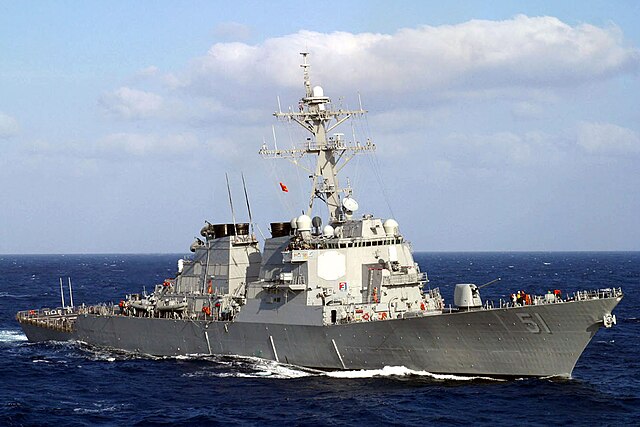
The lead ship of the class was ordered on 2 April 1985 to Bath Iron Works. She was laid down on 6 December 1988, launched on 16 September 1989 and commissioned on 4 July 1991. So she was launched three months before the cold war ended (general date given December 3, 1989) but completed months before the collapse of the Soviet Union on 26 December 1991. Before commission the head of the Operational Test and Evaluation Force was present for the initial phases of testing. Ashrore, her future crew was already familiarized for months in land-based test facilities having all replicas of systems onboard, notably the CiC. Combat systems testing were preformed at the Combat System Engineering Development Site in Moorestown (New Jersey) and propulsion plant testing at the Gas Turbine Ship of the Land-Based Engineering Site in Philadelphia (Pennsylvania). They greenlighted limited production based on results.
Admiral Burke (aged then ) was present in person at her commissioning ceremony on 4 July as said, held on the waterfront in downtown Norfolk.
After post-commissioned qualifications in 1991-1992, had had extensive testing at sea with many Navy officers and shipyard engineers on board to try to iron out all the teething shipboard systems requiring attention. After fixes, she underwent a new phased of testing to see the effectiveness of modifications made, to be incorporated on later, delayed destroyers of the class. She missed the gulf war due to this process.
Her first deployment was in the Mediterranean Sea and Adriatic Sea in 1993 as “Green Crown” for Operation Provide Promise. For her second deployment in 1995 she became the “Red Crown” in support of the No-Fly Zone over Bosnia-Herzegovina. Her third deployment in 1998 was in the Adriatic and Red Sea as well as the Black Sea, as well as taking part in many NATO exercises. In 1999-2000 she was in overhaul maintenance. Her fourth Med Tod in 2000–2001 saw her back in the Red Seas and Persian Gulf, enforcing UN sanctions against Iraq.
Her fifth deployment in 2003 saw her joining the USS Nimitz class Theodore Roosevelt-led carrier battle group (CBG) for Operation Enduring Freedom and Operation Iraqi Freedom. In this wartime cruise she fired her Tomahawk missile strike over Iraq and escorted merchant ships and auxiliaries as well taking part in leadership interdiction missions in the northern Arabian Sea. She also took part in counter-piracy missions in the Gulf of Aden and sailed back home in June 2003. In March 2003 she was reassigned to DesDiv 2. She won a Navy Unit Commendation, 3 Meritorious Unit Commendations, 3 Battle “E” and National Defense Service Medal, Armed Forces Expeditionary Medal, Kuwait Liberation Medal, plus 5 Sea Service Deployment Ribbons.
Next she was reassigned in 2005 to DesDiv 22, and became escort for CBG George H.W. Bush, Carrier Group 2. In May 2007 she ran aground off Cape Henry Light, entrance to Chesapeake Bay and Commander Esther J. McClure was relieved of command.
In October she was bacck in the red sea and for anti-pirate operations in Somalia. In 2009 she covered AFRICOM’s Africa Partnership Station and represented the US in Seychelles to secure a forces status agreement. By August 2010 she entered BAE Systems shipyard in Norfolk for DDG Modernization to extent her service life for 40 years…
On 23 September 2014 this was completed. She took part in the intervention against ISIS, and fired Tomahawks in Syria when in the Red Sea. In 2018 she made two 3-month overseas deployments and back to Norfolk. In 2019 she entered GDNS NASSCO’s shipyard, Norfolk, for missile ballistic missile modernization capability.
In March 2021 she went from the Atlantic to Rota in Spain, and DesDiv 60 to test notably her extensive upgrades, such as the Aegis Baseline 9 and SeaRAM CIWS. For the first time she crossed the Arctic Circle in May 2021. She was back home in December 2021 after a trip of 44,000 miles between touring Europe, the Baltic Sea, Black Sea, Mediterranean, Barents and Arctic, visiting Tallinn, Helsinki, Gdynia, Varna, Constanta, Golcuk. In March 2022 she was awarded the 2021 “Battle E” Winner for DsDiv 60. In April 2022 she had the largest maintenance availability in Rota and started her 2nd forward-deployed patrol (FDP) in May 2022.
On 9 July 2022 she visited Riga and on 13–14 April 2024, with USS Carney she shot down 6+ Iranian ballistic missiles during the strikes on Israel.
More to come. She is expected to serve until 2050…
 USS Barry (DDG-52)
USS Barry (DDG-52)

USS Barry was laid down at Northrop Grumman Ship System at Ingalls Division in Pascagoula, on 26.2.1990. She was launched on 10.5.1991, and completed on 12.12.1992. In April 1993 she had her Final Contract Trials and 3 months of fixes at Ingalls Shipbuilding from May for her Post Shakedown Availability (PSA) including 4-week dry-docking and installation or prairie style propellers ad well as the Electro-Optical Sighting System (EOSS), and coating with a Passive Countermeasure System (PCMS) material as well as stiffening the fuel tanks and and installation of a gray water collection system. On 21 October Captain Gary Roughead (future admiral and CNO from 2007 to 2011) was her first commanding officer, until relieved by Commander James G. Stavridis. From DesDiv 26 until 1995, she was in DesDiv 2 for administrative reasons. By November 1993 she was off Haiti for Operation Support Democracy, enforcing notably the embargo. In January 1994 she completed all her Qualification with the Atlantic Fleet’s highest score.
In March she took part in MAYFLYEX 94 she tested her Aegis combat system, destroying several test Exocet. In April she took part in FLEETEX 2–94 with USS George Washington CBG, including a covert SEAL team extraction in shallow water. On 20 May she departed HP Norfolk for her first Mediterranean deployment, still with George Washington CBG and present at the 50th anniversary of D-Day. She became “Red Crown” for the No-Fly Zone over Bosnia-Herzegovina.
On 7 October she sailed for the Persian Gulf and took part in Operation Vigilant Warrior, escorting both George Washington, and an amphibious assault group off Kuwait City as well as being Anti-Air Warfare Coordinator (AAWC) and main Tomahawk strike platform, earning a Meritorious Unit Commendation and 3 other Medals until back to Norfolk on 17 November.
In January 1995 she had a 3 months SRA at Moon Engineering, Portsmouth, including the Women at Sea (WAS) accomodations revisions.
Missing Logs here.
March 2003, she joins DesRon 26 and in 2004, she was at the annual Fleet Week in New York City. In 2006, she joined USS Gonzalez to escort the cruise ships Orient Queen, chartered by the US to help evacuate citizens in the 2006 Israeli-Lebanon conflict. On 1 March 2011 she returned to the Mediterranean Sea for the 2011 Libyan civil war standoff. On 19 March 2011 she fired 55 Tomahawk on Libyan air defense objectives under UN Security Council Resolution 1973, and Operation Odyssey Dawn. On 28 March she assisted a P-3C Orion and A-10 Thunderbolt destroying three Libyan Coast Guard boats firing on merchant vessels.
In late August 2013 with USS Gravely, Mahan and Ramage she patrolled the eastern Mediterranean Sea for a possible military intervention in the Syrian civil war.
By early 2016 her crew switched to USS Lassen in Yokosuka (there from 2005 to 2016). She had her midlife modernization prior, notably with Aegis Baseline 9 and fully integrated bridge and other upgrades. In 2022 she was part of Carrier Strike Group 5, CBG USS Ronald Reagan with USS Benfold and USS Chancellorsville.
She was sent to Naval Station Everett for routine maintenance and by August 2023 was opened to the public at the Seattle Fleet Week. New logs coming whe available.
 USS John Paul Jones (DDG-53)
USS John Paul Jones (DDG-53)
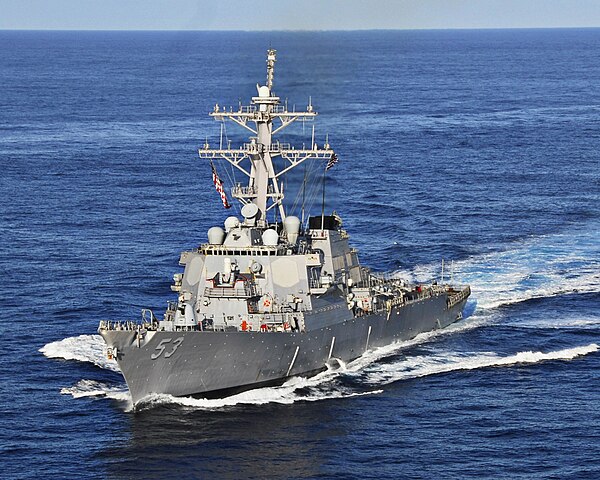
AT SEA (Mar. 16, 2008) The guided-missile destroyer USS John Paul Jones (DDG 53) steams into position during an Expeditionary Strike Force (ESF) exercise. The Nimitz Carrier Strike Group (CSG) recently participated in an ESF with the Essex (LHD 2) Expeditionary Strike Group (ESG). The ESF exercise was designed to test the ability of the Strike Groups to plan and conduct multi-task force operations across a broad spectrum of naval disciplines and to refresh skills in completing complex missions that require capabilities that are broader in scope than the individual Strike Groups can provide alone. U.S. Navy photo by Mass Communication Specialist 3rd Class Joseph Pol Sebastian Gocong (Released)
USS John Paul Jones, one of the longest sported name in the USN (3 Paul Jones inc. a Bainbridge and a Clemson-class, 1 previous John Paul J. Forrest Sherman class) was laid down at General Dynamics, Bath Iron Works on 8.8.1990. She was launched on 26.10.1991 and completed 18.12.1993. She was selected as the class Shock Trial platform, subjected to several close range explosions to obtain data about their survivability. She was probably the most demanding and complex surface ship shock trial test ever. In the 1990s she completed four deployments to the Persian Gulf and on 7 October 2001, launched her first Tomahawk over Afghanistan for Operation Enduring Freedom.
In June 2010 she started a ten-month overhaul, notably for her machinery control system and other electrical systems. On 10 June 2011 she took part in Navy Days off Malibu, with the ship opened to families. On 29 November 2011 USS John Paul Jones she was the first deployed after her DDGMOD (HM&E) upgrade, ported to the rest of the class. In 2012 she takes part in the movie “battleship”. On 1 November 2015, she took part in Fierce Sentry Flight Test Operational-02 Event 2, a $230 million missile defense test off Wake Island, she shot down a simulated anti-ship cruise missile but failed with a medium-range ballistic missile launched from a C-17. This trigerred a need for a new anti-ballistic missile asset.
On 18 January 2016, she sank the decommissioned USS Reuben James with her new anti-surface variant of the SM-6 SAM, a first, at the Pacific Missile Range near Hawaii. On 3 February 2017 she made a successful ballistic missile intercept off Hawaii using Standard Missile-3 (SM-3) Block IIA. No logs for 2018-2024 yet. She won 7 Batte “E” and earned a Meritorious Unit Commendation as part of USS Enterprise battle group for 1992-1994.
 USS Curtis Wilbur (DDG-54)
USS Curtis Wilbur (DDG-54)
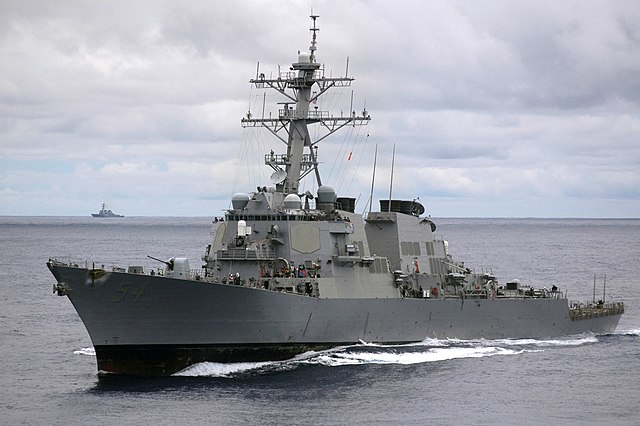
USS Curtis Wilbur was laid down General Dynamics Bath Iron Works on 12.3.1991, she was launched on 16.5.1992 and completed in 19.3.1994. She was part of the Pacific fleet. This summer of 1994 she took part in RIMPAC ’94, acting as Force Air Defense Coordinator and the Board of Inspection and Survey conducted Final Contract Trials on board, becoming the first in class, second ever to complete this examination while in mission.
In October she became the first Aegis ship to integrate crewomen. She made another WestPac on 31 July 1995 but transited to the Persian Gulf. Directed by the Naval Forces Central Command, she supported Southern Watch and Vigilant Sentinel staying her for 100 days as Air Warfare Commander, Surface Warfare Commander, Undersea Warfare Commander, Strike Warfare Commander as part of the 5th Fleet Expeditionary Task Force enforcing a blockade to Iraq.
In September 1996 she joined the 7th Fleet, swapping from San Diego to Yokosuka and had her Tailored Ship’s Training Availability II and III, first ever to validate her Final Evaluation Period. On 15 February 1997 she was part of USS Independence CBG for ex. Tandem Thrust ’97 and Cobra Gold as Air Warfare Commander.
She took part in other exercises such as Javelin Maker, Missilex 97-4, Aswex 97-6JA, Harmex 97-2, Annualex 09G, and Comptuex and became DesRon 15 1997 Battle Efficiency Winner. In January 1998 she took part in Sharem 108-1 and departed for the South Pacific stopping at Singapore, Australia, Guam, Hong Kong, South Korea and Japan as well as Merlion ’98 and being present at the Shimoda Black Ship Festival, a popular review of foreign warships but also celebrating the Dawn of Japan’s Modernization.
In June 1998 USS Curtis Wilbur had a 2nd SRA in Yokosuka over 9 weeks, gaining JTIDS (Link 16), JMCIS 98, INMARSAT B, and she was taunted as the most capable destroyer in 7th Fleet. She had her sea trials and requalifications in August 1998 before combined Exercise FOAL Eagle ’98 with Korea and completing her Fire Support and defense qualification as well as ECERT at TSTA II followed by Sharem 127 with the Korean Navy and a March 1999 deployment with USS Kitty Hawk CBG.
After Tandem Thrust ’99 she was ordered to the Persian Gulf with Kitty Hawk and Chancellorsville with a high speed transit and arriving on 18 April 1999. She took part in Operation Southern Watch, No-Fly Zone over Iraq and started Maritime Interception Operations for the 5th Fleet. But also exercises such as Nautical Swimmer ’99 (with the Royal Saudi Naval Forces)and Sharem 128 in the North Arabian Sea. Back to Japan she visited Australia and Pattaya in Thailand, arrived on 25 August.
On 1 October 2001 USS Curtis Wilbur departed again with the Kitty Hawk Strike Group for Operation Enduring Freedom in the Persian Gulf and while bacl, stopped at Phuket, Thailand from 13 to 15 December and Yokosuka on 23 December.
By February 2002 she worked with LHD USS Essex, cruisers Cowpens, Chancellorsville, and the DDs O’Brien, Cushing, John S. McCain, the frigates Vandegrift, Gary, and supply vessel John Ericsson with the JMSDF Sagami at Missilex ’02 on 7-8 February off Okinawa.
On 30 June 2007 she collided with a Russian Udaloy-class destroyer while docking in Vladivostok (minor damage). In March 2011 she accompanied USS Ronald Reagan CBG off northeastern Honshu for relief efforts after the Tōhoku earthquake and tsunami, possibly irradiated by the Fukushima accident.
In January 2016 she was in the south China sea in disputed waters, staying 12 nautical miles (22 km; 14 mi) of Triton Island as part of the “Freedom of navigation operations” (FONOPs). On 22 October 2018, she transited the Taiwan Strait with USS Antietam (CG-54) in the same gesture. On 16 September 2021, she was homeported to San Diego. She answered a distress call from two boaters stranded off the coast in March 2024, rescuing them.
No logs for the moment.
 USS Stout (DDG-55)
USS Stout (DDG-55)
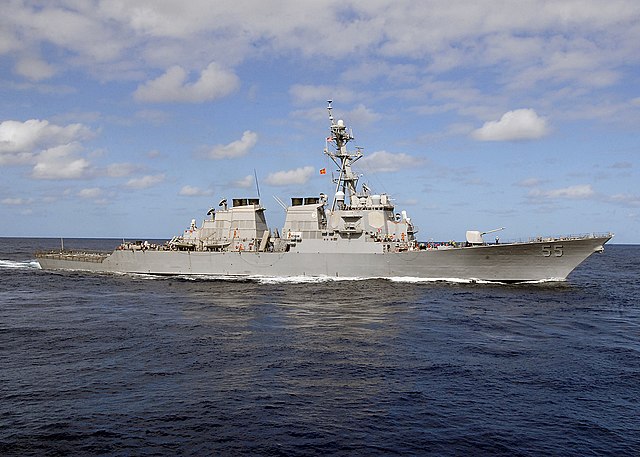
USS Stout was laid down at Northrop Grumman Ship System in Ingalls, Pascagoula on 8.8.1991, launched on 16.10.1992, completed on 13.8.1994.
In April 2008, she failed her Board of Inspection and Survey examination, being declared “unfit for sustained combat operations.” Since she passed all her 13 unit level training inspections. In March 2009 she was part of routine security operations 6th Fleet. On 15 July 2009 Fox News Channel reported she was training with the Georgian navy in the Black Sea.
On 1 March 2011 while in the Mediterranean Sea and off Libya, her commanding officer, Command Master Chief and eight other junior officers and NCOs were relieved by the Commander 6th Fleet for “pervasive pattern of unprofessional behavior” and “violations and disregard for naval standards of conduct and behavior”. It was assessed this resulted in poor crew morale and a hostile command climate. Still she had been awarded the 2006 Battle “E” still.
She took part in Operation Odyssey Dawn on 19 March 2011, launching Tomahawk cruise missiles at Libyan air defenses. On 28 August 2013 she sailed to the eastern Mediterranean Sea as Pdt. Bashar al-Assad had used chemical weapons in the civil war, notably the attested 2013 Ghouta attacks. Missing logs.
On 3 October 2020, she moored in Rota, Spain, after 215 days at sea, former record of USS Dwight D. Eisenhower (CVN-69) and USS San Jacinto (CG-56). This was due to the COVID-19 in part. As of January 2024 she is part of DesRon 28, NS Norfolk.
 USS John S. McCain (DDG-56)
USS John S. McCain (DDG-56)
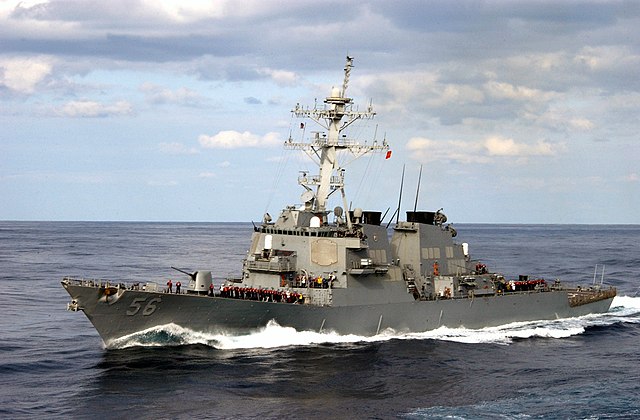
USS John S. McCain was laid down at General Dynamics Bath Iron Works on 3.9.1991, launched on 26.9.1992 and completed on 2.7.1994 under Commander John K. Ross. Former President George H. W. Bush, was the ceremony’s main speaker. She started her first deployment from 10 November 1995 to 10 May 1996 with the 5th and 7th fleets, stopping at Kochi, India, Fremantle and Newcastle in Australia as well as Suva in the Fiji and back to HP Pearl Harbor, then HP Yokosuka in June 1997. In October she visited Qingdao, first visit to Communist China apart Hong Kong in 15 years.
In January 2003 she was sent to the Persian Gulf, launching 39 Tomahawk missiles with the invasion of Iraq, being awarded the Navy Unit Commendation and Battle E for DESRON 15 2003 and 2004, then in 2007, the 2006 Battle E. On 11 June 2009, a Chinese submarine reportedly collided with her towed sonar array near Subic Bay and indeed damage was observed to the array but the even was toned down as shadowin US ships was not unheard of for Chinese subs.
In June 2009 she cased the North Korean cargo ship Kang Nam 1 as part of the UN embargo, to Burma, suspected of carrying arms for the Burmese junta government.
In July she was part of a goodwill tour at Yokohama’s international passenger terminal and opened to the public on the 22th.
In March 2011 with Ronald Reagan CBG she was deployed off northeastern Honshu to assist with relief efforts after the Tōhoku earthquake, exposed to leaking radiation from Fukushima I
In April 2013 she stayed off South Korea as tensions rose between the Koreas. In June 2014 she was in Subic Bay for CARAT exercises.
On 2 October 2016 with USS Frank Cable she made the first visit to Cam Ranh Bay, Vietnam, since 1975. In August 2017 she passed at 6 nm (7 mi; 11 km) of Mischief Reef, South China Sea, for a freedom of navigation stance with China’s spokeperson expressing “strong dissatisfaction”. She intercepted frantic messages from a nearby Chinese frigate warning her presence in Chinese waters to what she answer she was in recoignised international waters.
At 5:24 am on 21 August 2017 USS John S. McCain collided with the Liberian-flagged Alnic MC off Singapore, near the Strait of Malacca. Its not clear how navigation data could not have prevented this, but this was serious enough that nearby compartments were flooded, including crew berthing and machinery, as well as the communications rooms and ten US Navy sailors died.
The Maritime and Port Authority of Singapore started a SAR effort withing her Maritime Search and Rescue Region whilke the local Transport Safety Bureau launched a marine safety investigation, publishing her final report on 8 March 2018. On 27 August Navy and USMC divers had recovered the remains of all 10 sailors trapped in the floooded compartments. She was in drydock repairs in 2018, until October 2019. The final US investigation showed that the overly complex touchscreen system used for throttle control on board, combined ith the absenor of senior officers and training deficiencies contributed to the destroyer’s “loss of control” and so she crossed paths with Alnic MC. The latter was thus not to blame. The Navy decided to immediately revert to mechanical throttle controls on all its ships.
24 November 2020 saw the destroyer taking part in another Freedom of Navigation exercise, in Peter the Great Bay, in contested Russia-Japan waters and theatened to leave the bay by the destroyer Admiral Vinogradov, pending ramming. TASS claimed she chased the US destroyer out of the bay while the 7th Fleet spokesperson affirmed John S. McCain left the bay of their own accord after completing that exercise in what they viewed as international waters.
On 17 September 2021 USS John S. McCain left Yokosuka for NS Everett in Everett.
On 6 August 2023 she shadowed a Chinese-Russian trainign formation in international waters near Alaska.
On 4 September 2024, her captain was relieved of duty due to a “loss of confidence in his ability to lead” after a steering issue in the Middle East that coud have resulted in a grounding. More to come in the future.
 USS Mitscher (DDG-57)
USS Mitscher (DDG-57)
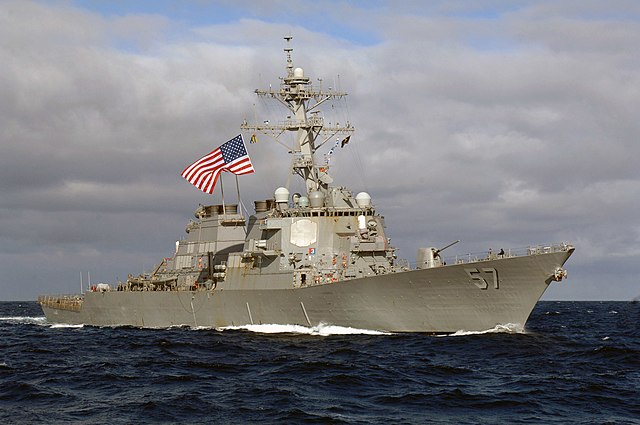
USS Mitscher was laid down at Northrop Grumman Ship System on 12.2.1992, launched on 7.5.1993 and completed on 10.12.1994. Mitscher was transferred from HP Norfolk, by December 1994, making 3 Mediterranean deployments and Caribbean exercises. In 2001, she was deployed with Carrier Group 2 (CBG Harry S. Truman) and in October 2006, she took part in the international exercise Neptune Warrior.
On 16 February 2007, Mitscher was awarded the 2006 Battle “E”.
From 23 July 2011 she was part of a strike testing anti-piracy capabilities, sailing with a Coast Guard Advanced Interdiction Team aboard Mitscher. These were highly trained maritime law enforcement specialists (Level III non-compliant boardings) for VBSS operations.
On 13 August 2011 she was part of TF 150 in the Gulf of Aden and provided assistance to the Sri Lankan-flagged cargo Al Habib which had engineering problems, running low on water. Her VBSS-AIT boarding party transported supplies to Al Habib via rigid-hulled inflatable boat.
On 24 February 2012 Commander Monika W. Stoker became the USN first female commanding officer, relieving Commander Brian K. Sorrenson.
On 2 June 2015 she welcomed the French Lafayette’s replica frigate Hermione in US waters. On 16 April 2022 she arrived at Norfolk after a surge deployment.
On 9 August 2023 the USN delcared she was about to receive a major upgrade to push her useful service to 35 more years to at least 2034. More to come.
 USS Laboon (DDG-58)
USS Laboon (DDG-58)

USS Laboon was laod down at General Dynamics Bath Iron Works on 23.3.1992, launched on 20.2.1993 and completed on 18.3.1995. By later 1996, she fired Tomahawk missiles on Iraq, first of her class to engage in combat. In 1998 she took part in NATO Ex. Dynamic Response 98 with USS Wasp’s Amphibious Ready Group (ARG).
On 12 September 2012 she was off Libya in “contingency” for an on-demand strike after 2012 diplomatic missions attacks. On 21 June 2015 she was in the Black Sea with the French radar ship ship Dupuy de Lôme, a stance of NATO’s presence after the Annexation of Crimea, and joint maneuvers with the Romanian Navy on 22-23 June. On the 27th she visited Batumi, Georgia, training with the local Coast Guard.
On 14 April 2018, she fired seven Tomahawk in the Red Sea in retaliation for the Syrian government’s use of chemical weapons in Douma. On 14 October 2023 she was sent by Lloyd Austin with the Dwight D. Eisenhower CSG (Philippine Sea, Laboon, Mason, Gravely) after the Hamas attack, joining Gerald R. Ford CSG already present. On 23 December 2023 she shot down four unmanned aerial attack drones from Yemen. On 26 December she shot down three anti-ship ballistic missile from Houthi rebels (SM-6), first intercept of a ballistic missile in combat for the class. On 6 January 2024 she claimed a houti drone.
On Jan. 9, 9:15 p.m. local time she was targeted by kamikaze UAVs and anti-ship cruise missiles, anti-ship ballistic missile in the Southern Red Sea, targeting shipping lanes. She took part in the shooting down of 18 UAVs, 2 anti-ship cruise missiles, 1 anti-ship ballistic missile as part of the Dwight D. Eisenhower, Gravely, Mason, HMS Diamond response.
On 14 January 2024 she shot down an anti-ship missile fired in her direction and on 2 February 2024, she helped vectoring F/A-18 Super Hornets downing 12 drones.
On February 6 she protected M/V Star Nasia, downing an anti-ship ballistic missile and on On 20 February another anti-ship cruise missile. More to come.
 USS Russell (DDG-59)
USS Russell (DDG-59)
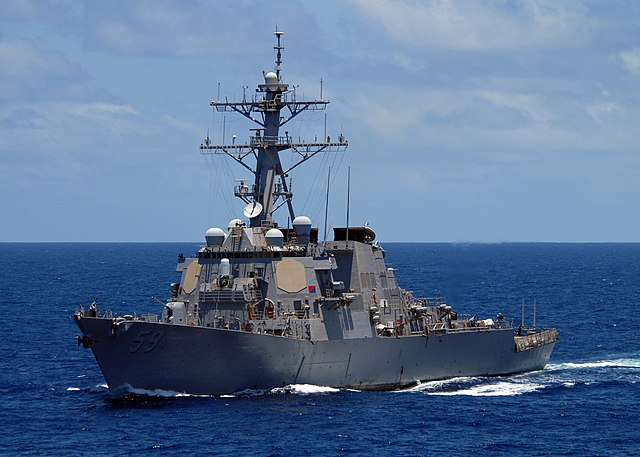
USS Russell was laid down at Northrop Grumman on 24.7.1992, she was launched on 20.10.1993, and completed on 20.5.1995. Logs missings for the 1990s. In May 2004, Russell departed for a four-month deployment along with several ships including USCGC Mellon, USS Salvor, USS Fort McHenry, and USS McCampbell. The deployment was she took prt in the ex. “Cooperation Afloat Readiness and Training” (CARAT) and on 15 April 2006, helped a distressed fishing vessel in the South China Sea. On 16 February 2007, she was awarded a Battle “E” and on 21 February 2008 with USS Lake Erie and USS Decatur she destroyed the US satellite US 193. On 17-21 May 2008 she took part in Exercise KhunjarHaad in the Gulf of Oman with FS Surcouf, HMS Montrose, RFA Wave Knight and others, practicing VBSS (boarding) and joint gunnery exercises. In June 2008 she rescued 70 from a disabled boat in the Gulf of Aden. In January 2013 she made a crew swap with USS Halsey at San Diego. On 4 June 2020 she made a Taiwan Strait crossing as par tof the freedom of navigation stance. More to come.
 USS Paul Hamilton (DDG-60)
USS Paul Hamilton (DDG-60)

USS Paul Hamilton was laid down at General Dynamics Bath Iron Works 24.8.1992, launched on 24.7.1993 and completed on 27.5.1995, homeported in San Diego. Missing 1990s logs. In 2003 she was in the Persian Gulf, Operation Shock And Awe. In 2009, this was Operation Iraqi Freedom. In July 2015 she escorted HMS Duncan to cover airstrikes against ISIL. In 2019 while in the waters of South Carolina she was harrasses by srones sent by PLAN-operated Hong Kong based cargo ship Bass Strait. No logs for 2020-2024.
 USS Ramage (DDG-61)
USS Ramage (DDG-61)
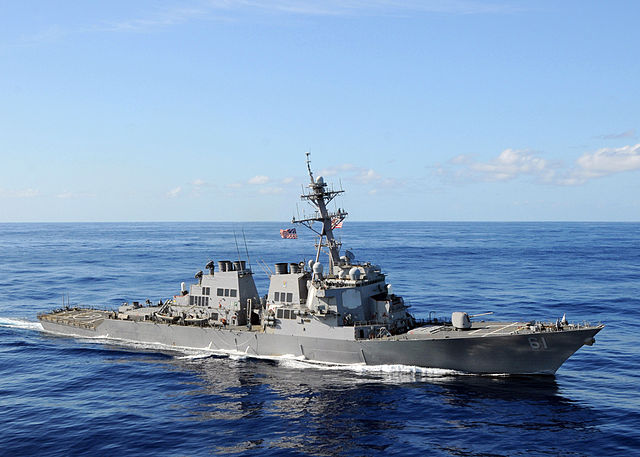
USS Ramage was laid down at Northrop Grumman on 4.1.1993, she was launched on 11.2.1994 and completed on 22.7.1995. Her construction was the occasion to use more efficient modular shipbuilding techniques using the latest “Product-Oriented Shipbuilding Technology” (POST). There were three separate hull and superstructure modules joined to form the complete ship. There were hundreds of sub-assemblies joined into dozens of assemblies, joined to form the three final hull modules using parallel lines to accelerate assembly. The deck house was lifted atop the mid-body module early on. Her launching was done over land on massive wheel-on-rail transfer system and onto a recovery drydock, ballasted down on 11 February 1994. She was christened in her outfitting dock, probably less spectacular that a traditional “launch”.
On 25 November 1996 she was deployed in the Mediterranean Sea, visited 6 countries for 16 port calls and awarded the Meritorious Unit Commendation, Sea Service Ribbon, Armed Forces Service Medal. In March 1997 she supported USMC in Albania for Operation Silver Wake. On 21 July 1997 she escorted the old USS Constitution in Massachusetts Bay. On 24 May 1999 she escorted USS Theodore Roosevelt CBG in the Med and Arabian Seas and took part in MED/MEF 2–99, making 15 port visits and Operation Allied Force off Montenegro. No logs for the 1990s. Hour after 11 September 2001 attacks she was deployed off NYC for extended radar coverage and prepared to possibly shoot down a suspected plane after negative interception. She was deployed with the George Washington SSG in the Arabian Sea for Operation Enduring Freedom and the exercises Neo Tapon 04 and Iron Siren 04.
In 2006 she returned in the Persian Gulf for Operations Argos Asterion and Argos Declion. She was present in the Ethiopian and Somalian hostilities by December 2006 coordinating a P-3. In August 2008 she returned to the Persian Gulf with USS Iwo Jima Expeditionary Strike Group (ESG). She took part in Operation Red Reef and Operation Trident Knight, back home in April 2009.
Newt she was in the North Sea and Baltic Sea for Joint Warrior 09, noably escorting HMS Illustrious. In October 2009 while in Gdynia a sailor on maintenance accidentally discharged her M240 machine guns into the port. No injuries. She was back in the Med on 5 January 2010 and by late January was in SAR after the crash of Ethiopian Airlines Flight 409. She also provided Ballistic Missile Defense and was back on 6 August 2010.
On 8 August 2013 she made a 8-month deployment with the 6th Fleet again with ballistic missile defense and ater made another from May 2012 to January 2013. She was present in 2014 during the Syrian Civil War after the use of chemical weapons and relieved USS Mahan on 23 August 2013 with USS Gravely and USS Barry, ready to fire their cruise missiles. On 28 October 2013 they rescued migrants 160 nm off the coast of Kalamata.
In February 2014 she was in the Black Sea for the Sochi Olympics and in August she was in esxamination at Norfolk (NNSY). By November 2015 she returned with the 6th Fleet, still ballistic missile defense, and USS Harry S. Truman CSG, making 28 Strait of Hormuz transits and back home 25 July 2016.
After her 2015–2016 deployment she had mid-cycle upgrade, 9 months in Pascagoula and back in operation by August 2017 and by October 2018 she was ordered to the 4th fleet for radar surveillance support, G-20 summit in Buenos Aires. By the fall 2019 she joined the 5th fleet as independent ballistic missile defense operator and flagship TF 55 commander after the assassination of Iranian General Qasem Soleimani. On 9 August 2023 it was announced a major upgrade overhaul to rpolongate her career by 35 years. On 8 October 2023 after Hamas attacked Israel Secretary Lloyd Austin assigned her to Gerald R. Ford CSG to the Eastern Mediterranean, protected also by Tico class Normandy, Ramage, Carney, Roosevelt and Thomas Hudner. She earned so far 4 Navy Unit Commendation, 2 Navy Meritorious Unit Commendation and 7 Battle “E”. New logs to come.
 USS Fitzgerald (DDG-62)
USS Fitzgerald (DDG-62)
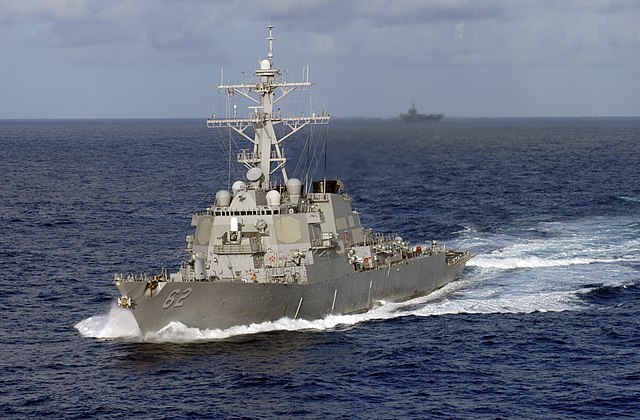
Fitzgerald was laid down at General Dynamics Bath Iron Works on 9.2.1993, launched on 29.1.1994 and completed on 14.10.1995. No logs for the 1990s. In early April 2004 it was announced her specialization with 14 other destroyers and three cruisers to counter ballistic missiles worldwide. She took part later in a “Super Swap” of crew with USS O’Brien, taking on board 95 as she was soon to be decommissioned. She wa shomeported to Yokosuka from 30 September 2004, 7th Fleet, DesRon 15. In March 2011 she was deployed with the CBG Ronald Reagan and brought relief to northeastern Honshu after the Tōhoku earthquake and tsunami.
On 16 November 2011 in Manila she hosted US Secretary of State Hillary Clinton and Philippine Foreign Affairs Secretary Albert del Rosario. They signed the Manila Declaration to resolve maritime disputes and commemorate the 60th anniversary of the American–Philippine Mutual Defense Treaty.
On 1 June 2017, Fitzgerald and the JMSDF made a show of force to North Korea with Ronald Reagan, USS Shiloh (Tico), Barry, McCampbell, and Mustin and were joined by Carl Vinson CBG with Lake Champlain (Tico), Wayne E. Meyer and Michael Murphy plus the Japanese Hyūga and Ashigara.
In May 2022, Fitzgerald returned to HP San Diego, DesDiv 2, assisting CarsStGroup 3 (CSG) USS Abraham Lincoln and also took part in RIMPAC 2022.
She was the only one fitted for trials with the Kongsberg Naval Strike Missile and fired them.
On 17 June 2017 at night USS Fitzgerald collided with ACX Crystal (Philippine-flagged container ship, 29,060 gross, 40,000 tons deadweight), some 56 nautical miles SW of Yokosuka. Her starboard side was badly mushed, as she was essentially rammed by the container ship’s bulbous bow below the waterline. Her machinery space was floodded as well as the radio room and two crew berthing spaces and the captain’s cabin was also crushed. 7 crewmen sleeping at the time in the flooded compartments were reported missing and later found by rescue workers. The CO and two sailors was also injured.
Investigations mixed the USN, USCG, Japanese Coast Guard, Japan Transport Safety Board and insurers of the Philippine ship under Rear Adm. Brian Fort.
Repairs were estimated at $368.7 million over a year and they overlapped with her planned life extension and electronics upgrade.
On 17 August 2017 after the first conlusions, the two senior officers and the senior enlisted sailor in charge that night were relieved of command and a dozen sailors were disciplined, including the CO for clear watchstanding failures.
Later while in overhaul it was announced she would not be upgraded to the latest version of the Aegis.
On 28 November 2017 her hull was punctured during the loading process to the floating drydock MV Transshelf for transfer to Pascagoula (19 January 2018) after a 2-month crossing from Japan. In August 2019 also concluded distraction and poor judgment of radar information as root causes. Repairs were completed on 3 February 2020, followed by sea trials and systems tests. She returned to San Diego.
 USS Stethem (DDG-63)
USS Stethem (DDG-63)
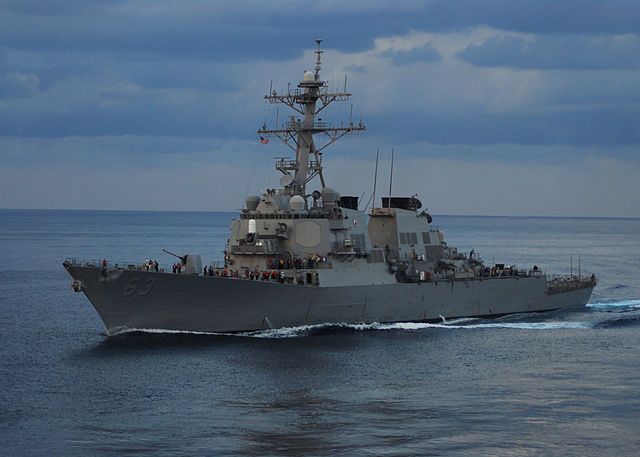
Stethem was laid down at Northrop Grumman Ship System on 11.5.1993, launched on 17.6.1994 and completed on 21.10.1995 as the 13th Arleigh Burke-class vessel. She transited the Panama Canal before commission at the Naval Construction Battalion Center Port Hueneme and on 15 February 1996 completed her Post Delivery Test-Trials. On 23 November 1996 she was in SAR for a C-130 crew off northern California. She earned a Coast Guard Meritorious Unit Commendation Medal and later Desron 21 Battle E. On 4 April 1997 she was in the Persian Gulf, and in Bahrain on 3 July. For three months she was primary Air, Surface Warfare Commander and Ready Strike Platform plus LINK Coordinator attached to USS Constellation and USS John F. Kennedy CBGs also taslking to USAAF engaged in Operation Southern Watch. She was also detached for 54 boardings.
During her trip she stopped at Singapore, the United Arab Emirates, Perth and Sydney before back to San Diego on 7 November. She had her CART II in May 1998 and TSTA III and was back to the Persian Gulf 16 April 1999 for Middle East Force 99-2 via Guam, Saipan, Singapore, and Thailand, 76 days on station with USS Theodore Roosevelt CBG and command ship, Northern Persian Gulf Maritime Interception Operations. She was back in San Diego 4 October 1999.
In January 2000 she was awarded with DesRon 21 Battle E and recipient of the Raytheon CIWS Award, Pacific Force Retention Award, Safety Award.
In mid-September 2000 off San Francisco she arrested the fishing vessel Gran Tauro, and towed it to San Diego. It carried 5 tons of uncut cocaine aboard worth $500 million.
On 13 January 2001 she made her 3rd deployment to the Persian Gulf with MEF 01-1, reporting to the 5fth Fleet on 28 February for 68 days on station, Operation Southern Watch and two exercises: Arabian Gauntlet and Neon Falcon. She also arrested an oil-smuggling vessel and was the watchdog of USS Harry S. Truman on 27 April before being back to San Diego on 28 June.
Before her next deployment she attacked USS John C. Stennis CBG as red force in a battle problem. In September she had an INSURV when New York City and Washington, D.C. were attacked by hijacked airines, and was called into station for Operation Noble Eagle, air surveillance of the approaches to San Diego.
On 30 September she was in SRA and received new equipment being also modified to test the Tactical Tomahawk Weapons Control System (TTWCS) for 9.4 million dollar. On 14 December the crew was on holiday leave and the crew was back training on mid-January 2002, performing also Tactical Tomahawk testing. She stopped at Puerto Vallarta and proceeded for an inter-Deployment Training Cycle with Desron 23 as flagship and in March CART II, then until May 2002, she was “red force” again against Abraham Lincoln in JTFEX.
She took part in the 60th Anniversary of Seabee Days in Port Hueneme and the Seattle Seafair festival then in 12 September 2002, led the Parade of Sail into San Diego Bay and Fleet Week celebration opened to the public. Later she tested her TTWCS and in October was red again vs. Constellation CBG.
In January 2003 same vs. Nimitz CBG. On 5 February she visited Puerto Vallarta and on 5 April was the first to launch a Block IV Tactical Tomahawk and on 8 May, with a live warhead for a strike on a San Clemente Island obhective after 2 hours and 700 miles flight.
On 14 May 2003 after SRA she took part in various missile-firing exercise while visiting Juneau, Alaska and Victoria and later played the “red” vs. USS Peleliu.
On 2 July 2017 she sailed 12 nm of Triton Island, South China Sea in her freedom of navigation exercises but on 1st August, 140 miles west of Subic Bay oe sailor was reported missing, SAR effort never found him until called off on 4 August 2017. No logs for later years.
 USS Carney (DDG-64)
USS Carney (DDG-64)
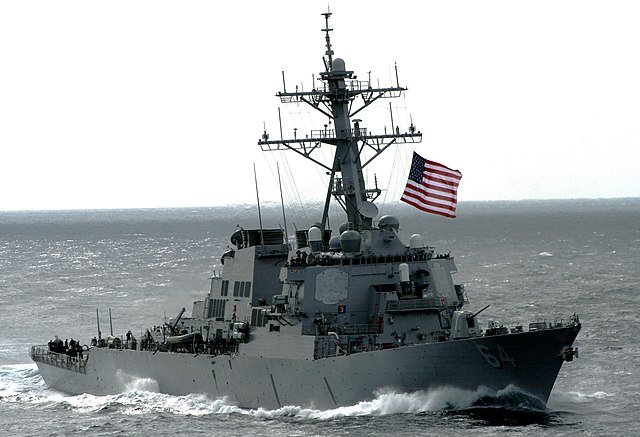
USS Carney was laid down at General Dynamics on 3.8.1993, launched on 23.7.1994, completed on 13.4.1996, assigned to DesRon 14, then DesRon 24 in September 1998. In 1997 she was deployed in the Mediterranean with USS George Washington CBG. In 1999, same, she took part in the bilateral Naval Exercise in Mediterranean Sea with the Japanese. In May 2001 she was at the NYC Fleet Week.
In February 2002 she joined USS John F. Kennedy CBG for technical evaluations of Cooperative Engagement Capability systems in Puerto Rico. She returned in the Med and Persian Gulf in 2002 for Enduring Freedom. On 10 June 2002 she was visited by Sec. Donald Rumsfeld while in Manama, Bahrain. In December 2003 she took part in the Vandel Exercise. On 13 August 2004 she entered NS Mayport to avoid Hurricane Charley.
In March and April 2007 she visited St. Kitts, Nevis, Antigua, Barbuda, St. Lucia, and Barbados. In November 2007 she served with Carrier Strike Group 10, USS Harry S. Truman in the Middle East and scores of multi-national exercises, back to Mayport on 4 June 2008. In July she was at Philadelphia’s 4 July celebrations. On 8 September she was at NYC 400th anniversary of Hudson’s arrival.
On 2 January 2010 she rerurned with the 5th Fleet and 6th Fleet and USS Dwight D. Eisenhower CSG and in May, worked with TF 150 and CTF 151 for security operations, and multinational exercises Arabian Shark 2010, Khunjar Haad 2010, Eagle Salute 2010, and back to Mayport on 31 July 2010.
On 1 August 2011, she departed for Standing NATO Maritime Group 1 and disrupted 4 piracy attempts, boarded 9 vessels, disarmed and captured 30 suspected pirates as part of Operation Ocean Shield.
On 17 October 2013 she departed HP Mayport for a 7 month deployment, back on 25 May 2014, performing Maritime Intercept Operations.
On 25 September 2015 she was homeported to Rota, Spain and on 29 July 2016 she recued 97 migrants on adrift inflatable watercraft.
In August she took part in Odyssey Lightning, escorting USS Wasp striking ISIS in Libya and also fired illumination rounds for the Libyan ground forces fighting them in Sirte, bombarding them with her 5-inch gun (285 shells).
In November 2016 she escorted Pdt. Obama’s visit to Greece at Drapetsona. By late March 2017 she was at HMNB Clyde, Scotland for NATO Joint Warrior.
On 17 February 2018 she sailed with USS Ross (DDG-71) in the Black Sea after increased tensions between Russia and the U.S.
On 27 June 2020, she left HP Rita for Mayport. On 8 October 2023 whe Hamas attacked Israel she was directed to join Gerald R. Ford carrier strike group in the Eastern Mediterranean with USS Normandy (Tico), and sisters USS Carney, Ramage, Roosevelt and Thomas Hudner. Until December 2023 she took her share destroying Houthi drones and missiles in the Red Sea. 19 October 2023: 3 cruise missiles, 8 drones, the 4 cruise missiles and 15 drones in nine hours. On 29 November 2023, she short down at KAS-04 drone and on 3 December she shot down 3 drones but could not prevent ballistic missiles strikes.
On 16 December 2023 she shot down 14 UAS and was visited an congratulated by Vice Admiral Brad Cooper (5th Fleet) warding sailors for “exceptional performance” adn the crew’s Navy’s Combat Action Ribbon, then the Navy Recom. medal to CO Jeremy Robertson, and another sailor, a Bronze Star and others.
On 13 January 2024 she fired Tomahawks at Houthi rebels in Yemen but could not prevent the British oil tanker MV Marlin Luanda to be hit on 26 January 2024 but she shot down an anti-ship ballistic missile and on the 30th another and a SM-6 missile, first acknowledged intercept.
On 5 March 2024, she downed an anti-ship ballistic missile and 3 UAS. On 13–14 April 2024, with class lead ship USS Arleigh Burke she shot down 6+ Iranian ballistic missiles. She was back in Mayport on 20 May 2024 after 7 month on station. She was the most combat action of any US ship since World War II.
 USS Benfold (DDG-65)
USS Benfold (DDG-65)
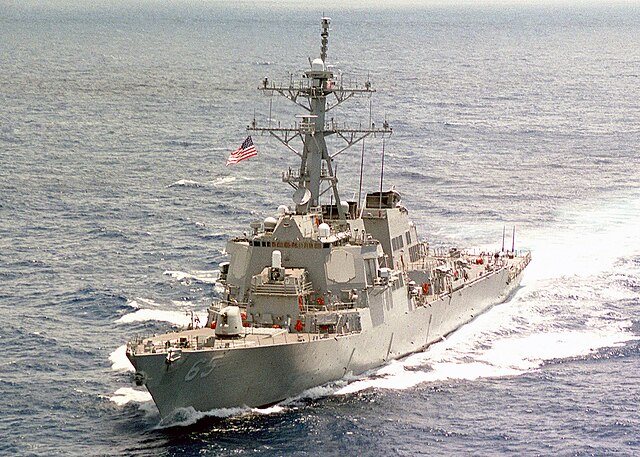
Benfold was laid down at Northrop Grumman in Pascagoula on 27.9.1993. She was laid down on 9.11.1994 and completed on 30.3.1996. From 14 August 1997 to 19 February 1998 she was deployed in the Persian Gulf, as between 18 June 1999 and 17 December 1999 but also the Pacific. From 13 March 2001 to 15 September 2001 she was in the Persian Gulf again as well as from 18 October 2004 to 1 March 2005, 13 September to 2006 13 March 2007, 4 May 2008 to 3 November 2008 and 8 September 2009 to 16 March 2010.
In 2011 she was drydock at BAE Systems for $32 million mid-life upgrade. Between 15 June 2012 to 11 January 2013 she was back in the Persian Gulf
In 2013 she receives extensive combat systems upgrades, such as Aegis Baseline 9C, Ballistic Missile Defense version 5.0, and the A(V) 15 SONAR Suite, ad well as CEC. Frop 2 October 2015 to 2024 she was transferred to the U.S. 7th Fleet, HP Yokosuka. In 2012 she was invited to the Koa Kai naval exercises with very diverse drills. On 19 November 2017 she collided with a commercial tug off Sagami Bay. Damage was minimal, no injuries.
She also later took part in a serie of Freedom of Navigation operations (FONOPS) in the South China Sea, on 12 July 2021 she was in the Paracel Islands, on 8 September 2021 in the Spratly Islands as well as later on 18 January 2022 and the paracels a few days later, the returned there on 13 July and the Spratly 3 days later. On 6 August 2023, she shadowed a joint Chinese-Russian patrol near Alaska. On 9 August the Navy announced plans to have her prolongated for 35 years and to rotate USS Benfold to Everett in Washington, USS Preble going to Yokosuka.
 USS Gonzalez (DDG-66)
USS Gonzalez (DDG-66)
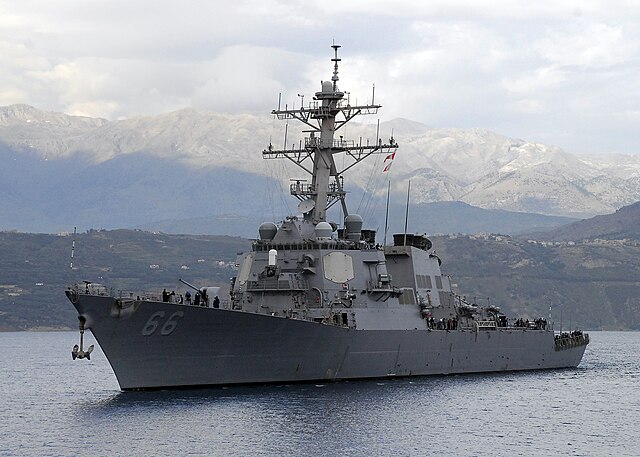
Souda Bay, Crete, Greece (Jun. 06, 2008) — The guided missile destroyer USS Gonzalez (DDG 66) arrives in Souda harbor for a routine port visit. Gonzalez has a crew size of 340 and is homeported in Norfolk, VA. She is currently on a scheduled six-month deployment and assigned to Standing NATO Maritime Group TWO (SNMG2) as the U.S. Navy representative to the NATO Response Force.
U.S. Navy photo by Paul Farley
USS Gonzales was laid down at General Dynamics on 3.2.1994, she was launched on 18.2.1995 and completed on 12.10.1996. On November 12, she grounded on a coral reef at 0800, off Sint Maarten. She damaged her sonar dome and blades on her screws. Repairs cost was evaluated to $10 million and she was back in service by September 1997. She was part of Operation Allied Force, firing Tomahawks at Serbian targets in 1999 and Gonzalez assisted Seabourn Spirit after an attempted pirates attack off Somalia in 2005. On 1 March 2006 she rescued an Iranian ship drfiting, engine broken since 18 February. On 18 March 2006 she captured suspected pirates wuth USS Cape St. George. An they droved others 25 nm (46 km) off Somalia. On 17 July 2006 she helped evacuating citizens from Lebanon. By May 2022 she was HP to Norfolk, DesRon 28, wrking with CSG 8, USS Harry S. Truman. More to come.
 USS Cole (DDG-67)
USS Cole (DDG-67)
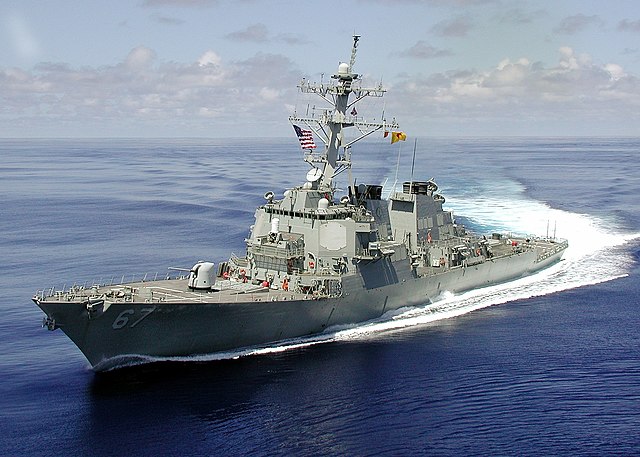
USS Cole was laid down at Northrop Grumman on 28.2.1994, launched on 10.2.1995 and completed on 8.6.1996. Logs missing. In 2000 shehad her Inter-Deployment Training Cycle and in March-April had her COMPTUEX 00-2 in CDG 2 led by USS George Washington in the Gulf of Mexico. On 9-22 May she was prt of Joint Task Force Exercise 00-2 with the battle group, off Cherry Point and Virginia Capes. On 8 August she departed for the Mediterranean and Adriatic.
On 12 October 2000, while anchored in Aden for refueling she was attacked by Al-Qaeda suicide bombers, sailing a small boat, detonating explosive charges on her flank. The blast punched a port side hole 40 feet (12 m) in diameter, killing 17, injuring 37 while under CO Kirk Lippold.
Injured sailors were evacuated to various hospitals in Aden by French Transall C-160 from Djibouti while medic teams from there treated the wounded. Later they were evacuated by C-9s. Cole was back to the US on the Norwegian heavy-lift ship MV Blue Marlin, off-loaded on 13 December on a dredged deep-water facility at Pascagoula and repairs started at Northrop Grumman Ship Systems, Ingalls. On 14 January 2001 she started her restoration process and on 1 July 2001, administratively transferred to Carrier Group 2 (Harry S. Truman).
On 14 September 2001 at night she was at sea again, and she departed on 19 April 2002 for Norfolk. On 3 December she was transferred to DesRon 22, COMDESRON 18, Enterprise Battle Group. A reward of up to $5 million was offered by the US Gvt. for information leading to the arrest of those who helped the attack. Al-Qaeda was suspected after an already failed attack on 3 January 2000 on The Sullivans. On 4 November 2002, Qaed Salim Sinan al-Harethi, one responsible, was killed in Yemen by CIA ops. with an AGM-114 Hellfire from a MQ-1 Predator drone. Later Abd al-Rahim al-Nashiri was tried as the alleged leader of the bombing at Guantánamo Bay and on 13 February 2020, the government of Sudan agreed to compensate families of the deceased.
On 20 August 2003, she teamed with the Argentine destroyer Sarandí for a short sail and carried the Visit Board Search and Seizure Team from USS Thorn for Maritime Interdiction Operation and COMPTUEX. On 21 August she had live furing (Killer Tomato Exercise) and personnel transfers drills with Sarandí by helicopter. Gonzalez joined the group and on 22 August, they had an RAS with USS John Lenthall, then back to Norfolk.
She joined Enterprise Strike Group from 10 September 2003 until October for exercises. On 29 November she made her first overseas deployment since the bombing with Gonzalez and Thorn, and with Cruiser-Destroyer Group 12, Enterprise strike group. On 1 December they had an underway replenishment with USS Arctic. She was back to Norfolk on 27 May 2004. In 2005 she took part in BALTOPS 05 and was present at the 4th July celebration in Philly.
She was back to the Middle East on 8 June 2006, and in Aden, her company honored the crewmembers killed. She was back home on 6 December 2006.
On 28 February 2008 she was back off Lebanon. Later she took part in the Atlantic Exercise Joint Warrior in 2014.
In May 2022, she was homeported off NS Norfolk, DesRon 28, CSG 8 (USS Harry S. Truman) and as of May 2024 she was back in the Middle East with USS Laboon crusiing the Persian Gulf and Mediterranean. On 1 October she intercepted Houti SM-3 and SM-6 missiles. More to come.
 USS The Sullivans (DDG-68)
USS The Sullivans (DDG-68)

Named after a famous ww2 destroyer about five enlisted brothers which went down with their cruiser, she was laid down at General Dynamics on 27.7.1994 launched on 12.8.1995 and completed on 19.4.1997 under CO Gerard D. Roncolato, the motto “We Stick Together” was painted.
On 26 April 1997 she sailed to Norfolk, Virginia and conducted replenishment qualifications with USS Platte. She arrived at new HP NS Mayport on 2 May.
After gunnery trials she started her shakedown to the West Indies (27 May), sailed off Puerto Rico and Virgin Islands for various live fire exercises. She also stopped at St. Thomas. On 29 June she fired tested her SM-2 ER. She was back to Mayport for the 4 July weekend before joining a major Virginia Capes exercise and abck on 12 July for upkeep.
After her post shakedown availability she was sent to Bath Iron Works for fixes and was back to Mayport on 23 November. On 8 December she joined USS Enterprise CBG off Georgia for training. When a T-45 Goshawk crashed after take-off she rescued the pilot as plane guard ship. Later she completed helicopter deck landing qualifications and was back in holidays on 12 December. From January 1998, she was part of many exercises and she ended in NYC “Fleet Week”.
On 26 May she sailed for Halifax for “Unified Spirit 98” with USS Nassau, two LPDs, two LSDs. with ships from Canada, Great Britain, Germany, France, Norway, Denmark, Belgium, and Portugal. After a stop at Boston she was back to Mayport on 1 July.
She trained midshipmen and welcomed her new CO E. Scott Hebner from 4 September 1998, assigned to DesRon 24, John F. Kennedy CBG. In October 1999 she started her maiden deployment in the Med.
In 2000 she was in the Arabian Sea for exercises and boarding operations. On 9 February, CO Daniel Paul Keller took command and she was back home by April 2000 after a 6-month deployment. After BEACHFEST at Port Canaveral she had a maintenance overhaul and experienced a failed attack in Aden, Yemen, on 3 January 2000 (2000 millennium attack plots). The boat was so overladen with explosives that it sank. It succeeded on USS Cole on 12 October 2000, prompting measures to mount light MGs and extra watchers while in port. En route for the Composite Unit Training Exercise 01-2 the crew learned about the September 11 attacks. She took part in Operation Noble Eagle, mid-Atlantic seaboard.
In February 2002 she was redeployed on the Arabian Sea for Operation Enduring Freedom.
On 20 March 2010 while entering Manama in Bahrain she struck a harbor buoy ($200,000+ in damag), CO Neil Funtanilla relieved of command by CiC TF50. On 17 August 2011 she mistakenly fired on a fishing boat instead of a towed gunnery target in a gunnery exercise off North Carolina and CO Mark Olson was relieved of command. No injuries, there were dud shells. On 7 May 2012 CO Derick Armstrong was in turn relieved of command after complains of female crew members for sexual harassment. On 18 August 2013 she provided medical assistance to MV Abir Alqaray No. 4 (Saudi dhow). On 18 July 2015 she had a misfire of a RIM-66 Standard, no injuries, small fire quickly extinguished. Thus was a freak event. By November 2017 she was in NYC on shore leave for Veterans’ Day.
The Sullivans in Portsmouth, England, in preparation to join United Kingdom Carrier Strike Group 21
On 14 September 2020 she joined HMS Queen Elizabeth’s TG for GROUPEX and Joint Warrior. On 19 January 2021 she was confoirmed for a deployment with the new British carrier as center of Carrier Strike Group 21 in 2021 to the Med. More to come.
 USS Milius (DDG-69)
USS Milius (DDG-69)
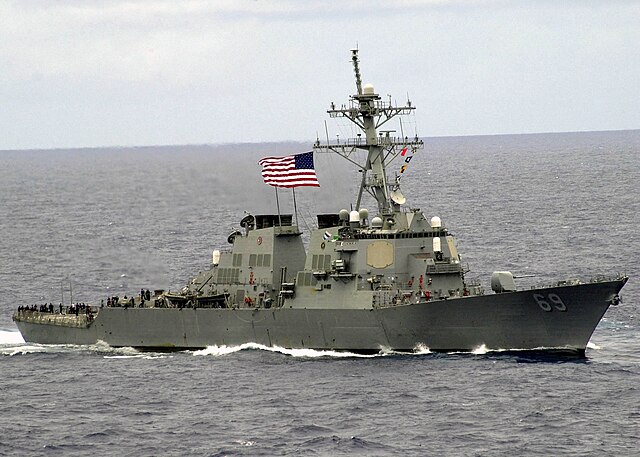
ABOARD USS CONSTELLATION (May 20, 2003). During a practice sea power demonstration for Constellation’s upcoming Tiger Cruise, the Destroyer Milius (DDG-69) proudly displays it’s large American Flag as it sails by Constellation (CV-64). Constellation and its battle group are returning from deployment in which it supported Operations Southern Watch, Enduring Freedom and Iraqi Freedom. U.S. Navy photo by Photographer’s Mate 2nd Class Daniel J. McLain
USS Milius was laid down at Northrop Grumman on 8.8.1994, launched on 1.8.1995, and completed on 23.11.1996. No logs for the 1990s. On 26 May 1998 until September 1998 she had her Maiden deployment. The on 22 June 2000 to December 2000 she made a first deployment in the West Pac–Indian Ocean–Persian Gulf, another between 2 November 2002 and 2 June 2003 and another between 6 December 2004 and 6 June 2005. In January 2005, she took part in Unified Assistance. On 6 December 2006 she launched a Block IV Tomahawk at the NS Test Range off California, over 869 miles before reaching its target at China Lake. On 12 September 2007 she was in goodwill visit to Manila. On 23 November 2021 she transited Taiwan Strait. Between 10 April 2007 and 8 October 2007 she had a scheduled Deployment with BHR ESG and between December 2008 and July 2009 she returned in the West Pacific, Indian Ocean and Persian Gulf area, as well as between 18 May 2010 and 16 December 2010, 11 January 2012 and 11 September 2012, 20 October 2014 and 25 June 2015 and in May 2018 she changed base for Yokosula and the 7th Fleet. On 9 August 2023, she was announced a prolongation after major overhaul for 35 years.
 USS Hopper (DDG-70)
USS Hopper (DDG-70)
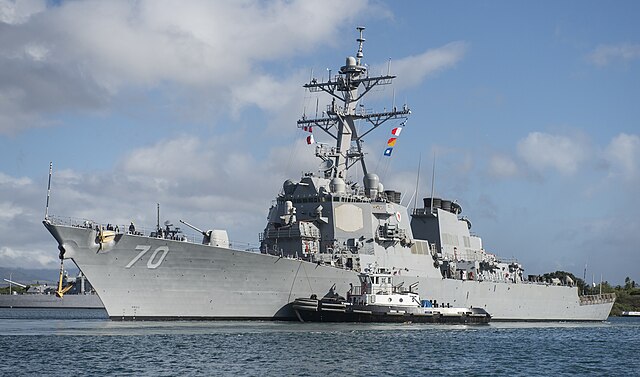
(U.S. Navy combat camera photo by Mass Communication Specialist 1st Class Charles E. White/Released)
USS Hopper was laid down at General Dynamics on 23.2.1995, launched on 6.1.1996 and completed on 6.9.1997. She took part in several dployments in East Asia and the Persian Gulf, notably RIMPAC 98, PACMEF deployments and an with an ESG in the Persian Gulf in 2004, then CARAT in 2006. She was the most advanced in terms of Ballistic Missile Defense. On 1 April 2002 she made another six-month deployment to the North Persian Gulf and on 12 November 2007, with USS Tarawa she deployed with the 5th and 7th Fleets.
On 6 January 2008 there was an incident with five Iranian Rev. Guards gunboats when she was with USS Port Royal and USS Ingraham, via the Strait of Hormuz. The gunboats approached at high speed in what was described as in a “threatening manner”. They were ther to look for a sailor missing from Hopper for 24 hours. At 200 yards (180 m) the destroyers heard, as translated, “I am coming to you. You will explode after a few minutes.” They prepared to fire when the Iranians suddenly turned away, dropped white boxes, that was not investigated. On 15 April 2011 she deployed from Pearl Harbor to Asia-Middle East. On 22 June 2014 she detected and tracked a test ballistic missile from the Reagan Test Site on Kwajalein Atoll, providing cital targeting data to a logng range ground-based interceptor to shoot it down. In January 2018 she made a freedom of navigation cruise, 12 nm from Scarborough Shoal claimed by the PLAN and Philippines in 2012. China complained she “violated China’s sovereignty and security interests”. More to come.
 USS Ross (DDG-71)
USS Ross (DDG-71)
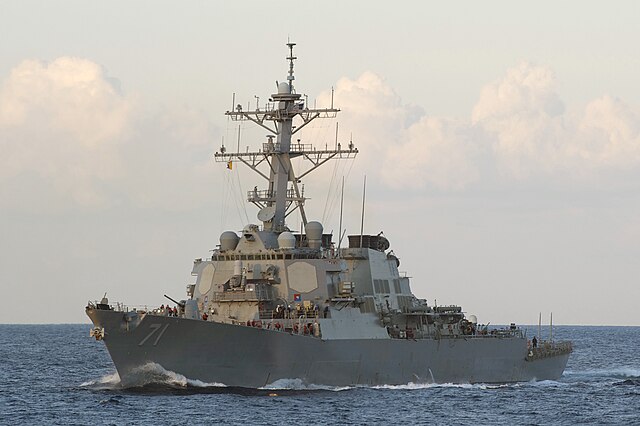
USS Ross was laid down at Northrop Grumman Ship System on 10.4.1995, launched on 22.3.1996 and completed on 28.6.1997 under command of Jeffrey R. Ginnow. She had a Combat Systems Ship Qualification Trial over six weeks and sailed for Pascagoula for her PSA, then to HP Portsmouth for her Basic Training Phase, Intermediate Training Phase and in 1999 entered Carrier Group 8 (Theodore Roosevelt) for a Joint Task Force Exercise before a six-month deployment scheduled on 26 March 1999. This was in the Mediterranean and Adriatic, for Operation Allied Force. She was back at Norfolk on 22 September.
On 15 May 2000, she was in Northern Europe for BALTOPS 2000, flagship, Commander of CarGpe 8 wit her sister USS Peterson and 50 ships from NATO. She visited Stockholm, and Kiel, back home in late June. On 16 October 2001, she was in the Mediterranean and Persian Gulf for Operation Enduring Freedom with USS Theodore Roosevelt CBG.
On 11 September 2001 she learned about the attacks and became Regional Air Defense Commander, North American Air Defense Command. She received for this the Arizona Memorial Trophy.
On 6 June 2005, she had a .50 cal. discharging while leaving her shipyard, hitting and nearby barge, entering it to destroy two washing machines insode. Itw as a botched check on its firing system. In 2005 she took part in UNITAS 47-06, replacing the Tico class cruiser Thomas S. Gates, damage by Hurricane Katrina. Her crew had R&R in Curaçao, St. Maarten, and Rio de Janeiro and she worked with the Argentinian, Brazilian, Chilean, Spanish and Uruguayan navies. Underway back home she sped up in heavy seas and received a tear but the flooding was contained and water pumped out.
In 2006, she made a six-month deployment to the Mediterranean with Standing NATO Maritime Group 1, making 850 vessel queries and commanded to 17 ships from various nations as well as performing 40 helicopter landings and takeoffs, 41 port visits. From 1 May 2006 to 7 November 2006 she cranked up 64,000 nautical miles (119,000 km; 74,000 mi). In Alicante in August she became flagship. She took part in Operation Active Endeavour.
In September 2014 with the war in crimea and Ukraine, she was sent to the Black Sea to train with Ukrainian ships in “Sea Breeze”. In November 2014, three sailors were attacked ashore in Istanbul by members of the Turkey Youth Union. In May 2015 she was buzzed by two Russian Su-24 Fencers at 500 m (1,600 ft) while on-station. RIA Novosti claimed she “acted aggressively” and was “scared away”, again in international waters for the USN.
On 21 October 2015 she intercepted an old Terrier missile for ASD-15 anti-ballistic missile testing, North Sea. In 2017 she performed ASW patrols off Norway and pushed in the Arctic Ocean. On 7 April 2017 with USS Porter in the Eastern Mediterranean she fired 59 Tomahawk at the Shayrat airfield in Syria after the killing of 80 civilians (4 April 2017, Khan Shaykhun chemical attack).
Ross later visited Ashdod on 10 October 2018 (Israel), hositng the ambassador. On 16 February with USS Carney she returned in the Black Sea for an “unspecified regional proactive presence mission”, following American federal prosecutors’ indictments against 13 Russian citizens suspended t have meddled with the U.S. Presidential campaign. In December 2019 she stopped in Odessa, Ukraine, for Xmas. On 6 September 2022 she was in Rota, departing for Norfolk and a scheduled port shift, relieved by USS Paul Ignatius.
On 12 November 2009 her upgrade was announced FY2012 to RIM-161 Standard Missile 3 as part of the Aegis Ballistic Missile Defense System.
In 2016, she operated with the 6th Fleet, NS Rota, Spain, replacing her an aft Phalanx CIWS 20mm Vulcan by the SeaRAM RIM-116, paired with Aegis. More to come.
Note: The followingFlight II, IIa, III will be completed in a 2025 update.
Read More/Src
Links
DDG51 development history (pdf)
en.wikipedia.org/ List_of_Arleigh_Burke-class
naval-technology.com
man.fas.org/ ddg-51.htm
navypedia.org/ arleigh_burke
www.navy.mil DDG-51
armyrecognition.com/ arleigh-burke-class
military.com/ ddg-51-arleigh-burke
hii.com/ arleigh-burke-class
on armyrecognition.com
news.usni.org/ extending-service 12-flight arleigh-burke
on twz.com/
on seaforces.org/
on shipbucket.com/
secretprojects.co.uk
Videos
Model Kits
all kits on scalemates.com/
I Love Kit 1:200, Trumpeter/Dragon 1:350 to HobbyBoss 1:700, and books like:
Die Arleigh Burke-Klasse, Schiff Profile No. 26 Stefan Ulsamer 2022
Arleigh Burke-Class Destroyers in Action No. 14031 by John Gourley 2015
Arleigh Burke Class Destroyers Warship Pictorial No. 24 Kurt Greiner 2006
3D
Nice 3D rendition by CSIS of DDG 75 USS Donald Cook, Flight II, with explanations.

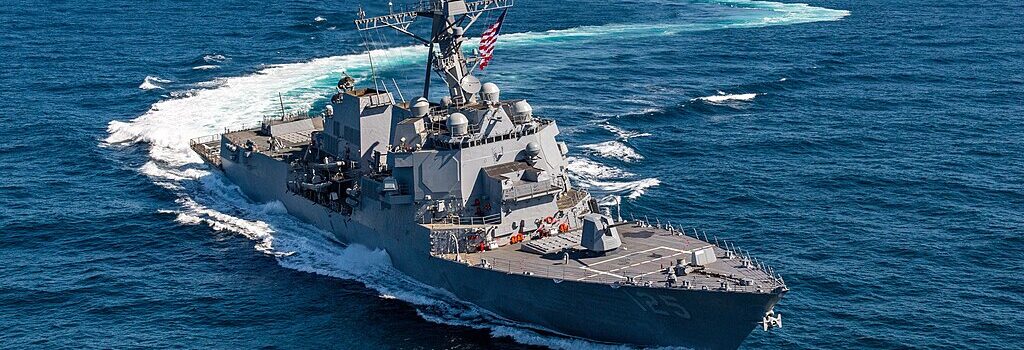
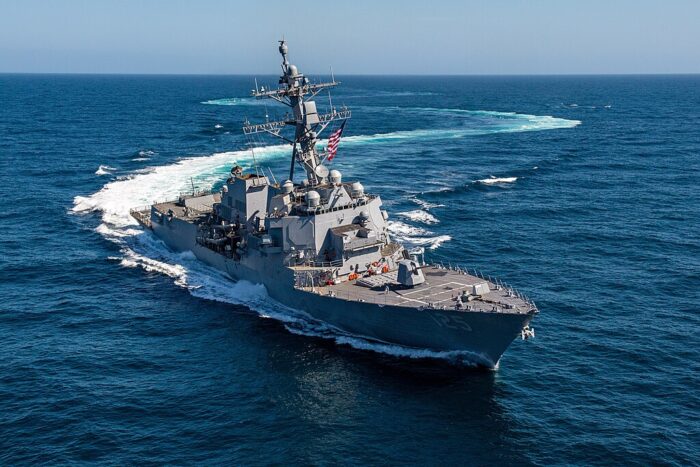
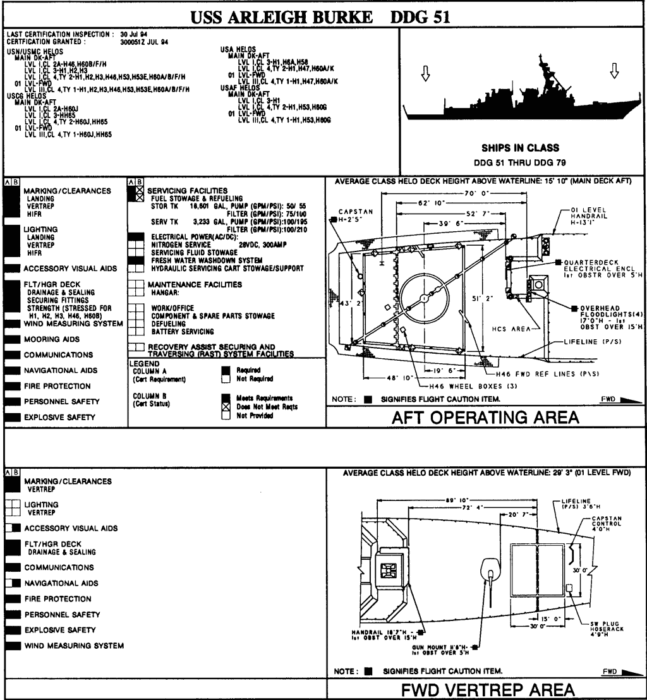
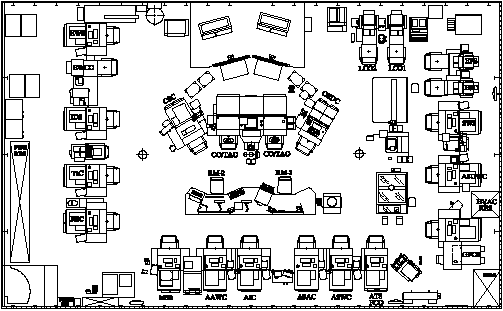
 Latest Facebook Entry -
Latest Facebook Entry -  X(Tweeter) Naval Encyclopedia's deck archive
X(Tweeter) Naval Encyclopedia's deck archive Instagram (@navalencyc)
Instagram (@navalencyc)





 French Navy
French Navy Royal Navy
Royal Navy Russian Navy
Russian Navy Armada Espanola
Armada Espanola Austrian Navy
Austrian Navy K.u.K. Kriegsmarine
K.u.K. Kriegsmarine Dansk Marine
Dansk Marine Nautiko Hellenon
Nautiko Hellenon Koninklije Marine 1870
Koninklije Marine 1870 Marinha do Brasil
Marinha do Brasil Osmanlı Donanması
Osmanlı Donanması Marina Do Peru
Marina Do Peru Marinha do Portugal
Marinha do Portugal Regia Marina 1870
Regia Marina 1870 Nihhon Kaigun 1870
Nihhon Kaigun 1870 Preußische Marine 1870
Preußische Marine 1870 Russkiy Flot 1870
Russkiy Flot 1870 Svenska marinen
Svenska marinen Søværnet
Søværnet Union Navy
Union Navy Confederate Navy
Confederate Navy Armada de Argentina
Armada de Argentina Imperial Chinese Navy
Imperial Chinese Navy Marinha do Portugal
Marinha do Portugal Mexico
Mexico Kaiserliche Marine
Kaiserliche Marine 1898 US Navy
1898 US Navy Sovietskiy Flot
Sovietskiy Flot Royal Canadian Navy
Royal Canadian Navy Royal Australian Navy
Royal Australian Navy RNZN Fleet
RNZN Fleet Chinese Navy 1937
Chinese Navy 1937 Kriegsmarine
Kriegsmarine Chilean Navy
Chilean Navy Danish Navy
Danish Navy Finnish Navy
Finnish Navy Hellenic Navy
Hellenic Navy Polish Navy
Polish Navy Romanian Navy
Romanian Navy Turkish Navy
Turkish Navy Royal Yugoslav Navy
Royal Yugoslav Navy Royal Thai Navy
Royal Thai Navy Minor Navies
Minor Navies Albania
Albania Austria
Austria Belgium
Belgium Columbia
Columbia Costa Rica
Costa Rica Cuba
Cuba Czechoslovakia
Czechoslovakia Dominican Republic
Dominican Republic Haiti
Haiti Hungary
Hungary Honduras
Honduras Estonia
Estonia Iceland
Iceland Eire
Eire Equador
Equador Iran
Iran Iraq
Iraq Latvia
Latvia Liberia
Liberia Lithuania
Lithuania Mandchukuo
Mandchukuo Morocco
Morocco Nicaragua
Nicaragua Persia
Persia San Salvador
San Salvador Sarawak
Sarawak Uruguay
Uruguay Venezuela
Venezuela Zanzibar
Zanzibar Warsaw Pact Navies
Warsaw Pact Navies Bulgaria
Bulgaria Hungary
Hungary

 Bundesmarine
Bundesmarine Dutch Navy
Dutch Navy Hellenic Navy
Hellenic Navy Marina Militare
Marina Militare Yugoslav Navy
Yugoslav Navy Chinese Navy
Chinese Navy Indian Navy
Indian Navy Indonesian Navy
Indonesian Navy JMSDF
JMSDF North Korean Navy
North Korean Navy Pakistani Navy
Pakistani Navy Philippines Navy
Philippines Navy ROKN
ROKN Rep. of Singapore Navy
Rep. of Singapore Navy Taiwanese Navy
Taiwanese Navy IDF Navy
IDF Navy Saudi Navy
Saudi Navy Royal New Zealand Navy
Royal New Zealand Navy Egyptian Navy
Egyptian Navy South African Navy
South African Navy






























 Ukrainian Navy
Ukrainian Navy dbodesign
dbodesign